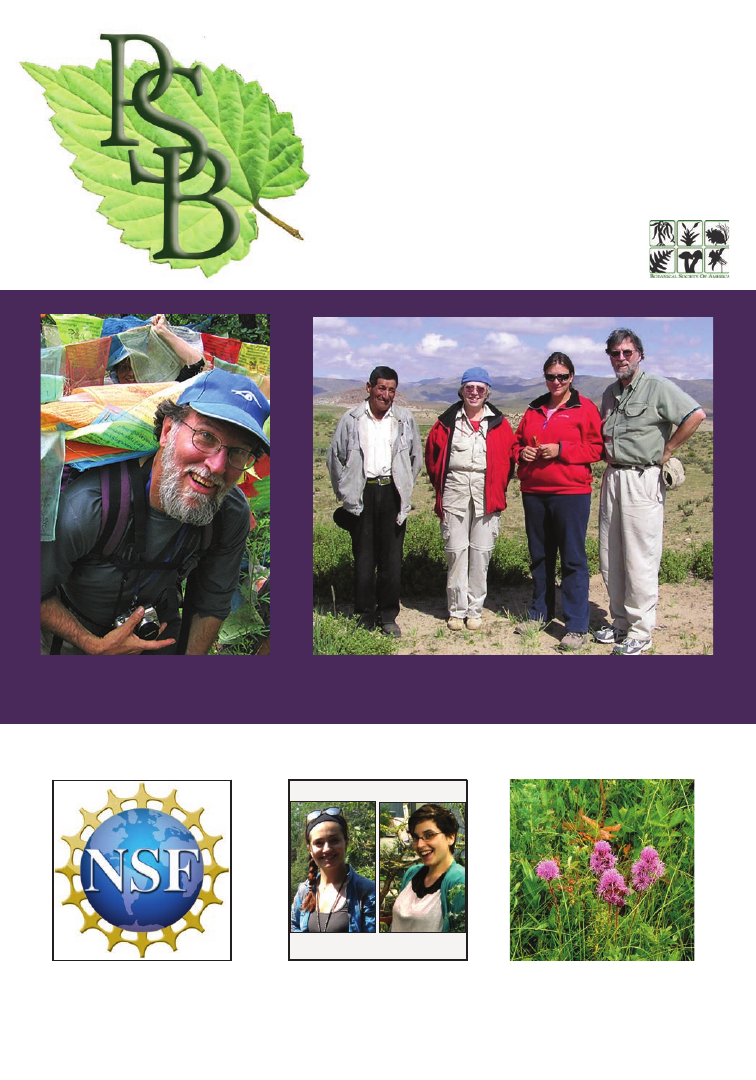
In This Issue...
Student reps’ guide to opportuni-
ties for students in 2016.... p.151
Conservation challenges in
Canada’s Nisku Prairie.... p. 140
What are the best practices on
interacting with NSF?... p. 131
PLANTS Grant Recipients and Mentors Gather at Botany 2015!
FALL 2015 VOLUME 61 NUMBER 4
BSA President Richard Olmstead on Increased International Cooperation in Botany
PLANT SCIENCE
BULLETIN
A PUBLICATION OF THE BOTANICAL SOCIETY OF AMERICA
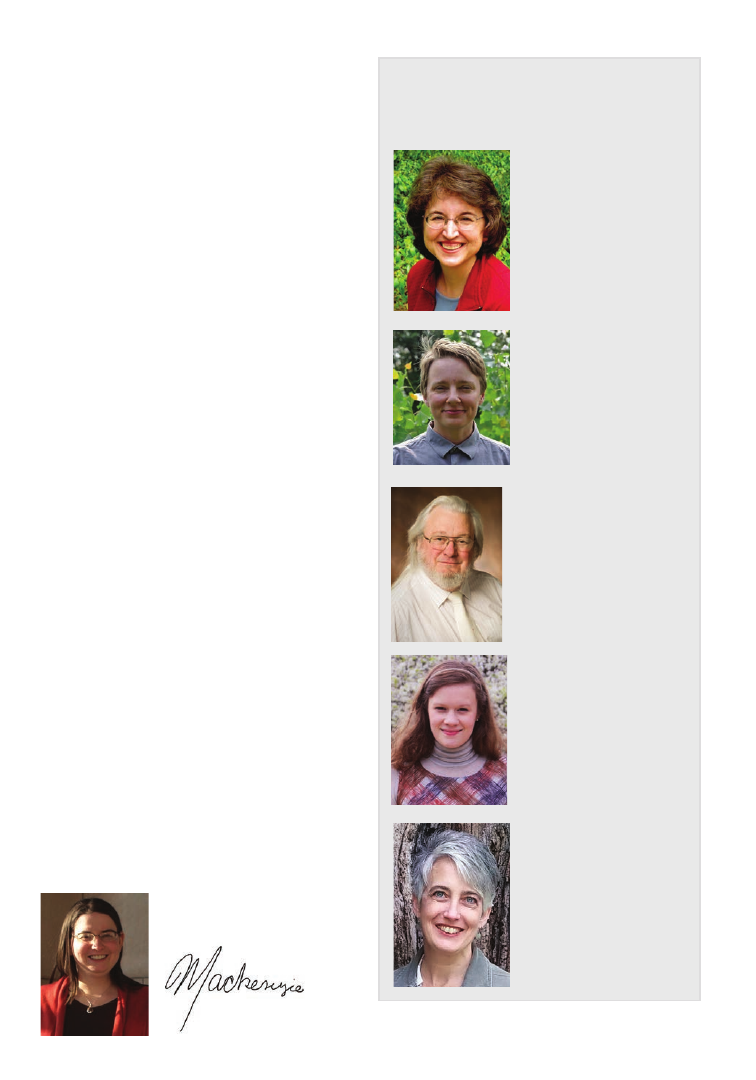
Fall 2015 Volume 61 Number 4
PLANT SCIENCE BULLETIN
Editorial Committee
Volume 61
Kathryn LeCroy
(2018)
Environmental Sciences
University of Virginia
Charlottesville, VA 22904
kal8d@virginia.edu
L.K. Tuominen
(2016)
Department of Natural Science
Metropolitan State University
St. Paul, MN 55106
Lindsey.Tuominen@metrostate.edu
Daniel K. Gladish
(2017)
Department of Biology &
The Conservatory
Miami University
Hamilton, OH 45011
gladisdk@muohio.edu
Carolyn M. Wetzel
(2015)
Biology Department
Division of Health and
Natural Sciences
Holyoke Community College
Holyoke, MA 01040
cwetzel@hcc.edu
Melanie Link-Perez
(2019)
Department of Biology
Armstrong State University
Savannah, GA 31419
melanie.link-perez@armstrong.edu
From the Editor
With this December 2015 issue, I am delighted
to unveil a new look and a new logo for the Plant
Science Bulletin. Botany is a dynamic, evolving sci-
ence and it is fitting for the Plant Science Bulletin-
to continually grow and change together with the
field and with its readers. The BSA staff and I have
been working hard to develop a new layout to fit
within a larger 7 x 10-inch format. It is our hope
that this new format will be attractive, improve
readability of the popular print version of the PSB,
and facilitate digital access of PSB content.
To accompany this new layout for the print PSB,
we will be redesigning the Plant Science Bulletin
webpage (http://botany.org/home/publica-
tions/plant-science-bulletin.html), where you can
easily access the most recent issue of the PSB, the
PSB archives, as well as recent BSA news items and
books currently available for review. Rob Brandt
and the BSA team will be adding additional web
features in the coming months. Check the PSB
page often for updates and for newly available
books!
Within this issue, I would like to draw your atten-
tion to valuable resources for both professional
and student members. You will find an in-depth
article (page 131) about the policies and proce-
dures at the National Science Foundation with tips
for preparing grant proposals. In the Student Sec-
tion (page 151), the student representatives pres-
ent an extensive list of grants and awards, as well as
outreach, training, and professional opportunities
aimed primarily at students. Finally, the Botanical
Society of America is calling for nominations and
applications for several awards that are relevant to
members in all stages of their careers (page 130). I
hope that you consider applying for these awards
or nominating your worthy colleagues.

120
SOCIETY NEWS
The International Botanist
Remarks by President-Elect Dick Olmstead
(Note: The video and slides from this lecture
from the Botany 2015 conference can be found
on the BSA’s Botany Conference YouTube chan-
nel at https://www.youtube.com/watch?v=hr-
lA43io0CQ.)
I
had an epiphany of sorts one rainy night in
2009 during a long treacherous microbus
ride while conducting fieldwork in the Peru-
vian Andes. A British woman seated next to
me explained why she had spent the last six
months volunteering and traveling in rural
Peru by saying that it wasn’t the immediate
experience that was most important to her,
but rather the lasting impact on her life of ex-
periencing the culture of a foreign country,
about which she would never feel the same
again. Months later, I realized just how true
this is. Ostensibly the reason for my travel
was to collect plants for my research, but after
the passage of time, the memories that stayed
with me were of people and places. Ironical-
ly, my personal history of international travel
began in Peru 41 years earlier as an exchange
student living in Lima and taking advantage
of the opportunity to travel and learn about
the country.
As my career as an academic botanist devel-
oped, that interest in travel served me well as
research interests in plant phylogenetics led
me to visit far-flung parts of the world and
to interact with scientists from around the
world. I would like to relate two of those expe-
riences, because I think they are illustrative of
the tremendous advantages that international
cooperation can yield.
International Research
Collaboration on Verbenaceae
Over the past 13 years, I have been involved
in research on the verbena family. This work
has taken me and/or my students to more than
a dozen countries. Botanists in each country
helped negotiate legal and cultural barriers. In
return, field trips with host country botanists
resulted in the collection of hundreds of plant
specimens for their herbaria and ours. But
equally importantly, the personal connections
that enhance the outcomes of the research
afford a marvelous opportunity for cultural
education of everyone involved. The tangible,
scientific outcomes of this project, which is
still ongoing, include collaboration among 18
scientists from five countries in research pub-
lications; Ph.D. degrees to six students from
five countries, whose research benefited from
Botany 2015
Presidential Address:
Richard Olmstead: The
International Botanist
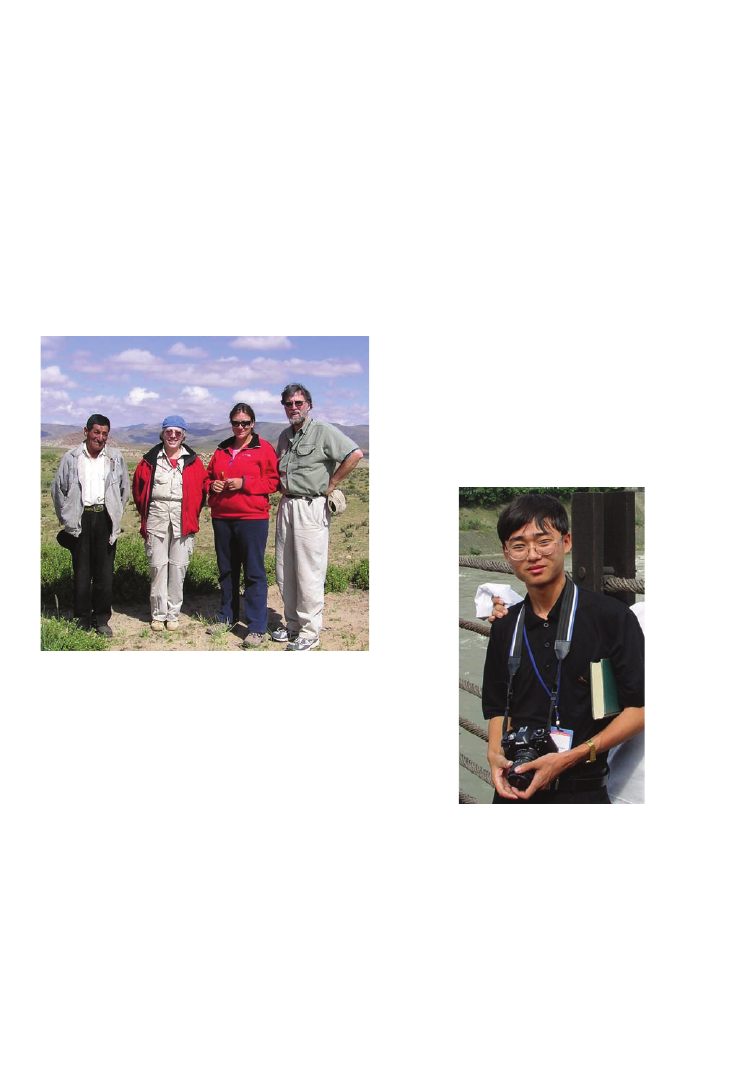
PSB 61 (4) 2015
121
the collaboration; international research ex-
change opportunities for three grad students;
numerous undergraduate participants; and
presentations at four international confer-
ences (as well as our Botany meetings). I ben-
efitted from their expertise and knowledge of
the local plants, while my collaborators ben-
efitted from the opportunity to participate
in high-impact publications (including sev-
eral in the American Journal of Botany) that
emerged from the collaboration (Figure 1).
Figure 1. Dick Olmstead with Pedro Estra-
da, María Múlgura, and Alejandrina Alaria in
Jujuy, Argentina.
University of Washington – Sichuan
University Undergraduate Exchange
in Environmental Sciences
With support from the NSF and the Univer-
sity of Washington, in 2000, we initiated an
exchange program for undergraduates in the
environmental sciences. Involving students in
research was central to this program. Today,
nearly 500 students have participated in the
exchange. My active participation was only in
the first few years, during which time a bota-
nist also was active on the Sichuan University
side.
Two students stand out in my mind from
among many who have gone on to profession-
al careers in science. Yuan Yao-Wu was among
the first cohort of Chinese students to enter
the program (Figure 2). After spending his ex-
change year working in my lab in Seattle, he
returned to China to complete his senior the-
sis at the Institute of Botany in Beijing before
coming back to the University of Washington
for his Ph.D. (the first of many in that cohort
to complete a Ph.D.). Yuan was an invited
speaker in the BSA Presidents’ symposium at
Botany 2013 and is now Assistant Professor at
the University of Connecticut.
Figure 2. Yuan Yao-Wu in Sichuan, China
(2002).
Rachel Meyer was in the second cohort of
UW students to study in Sichuan and partici-
pated in a student-led ethnobotanical study of
the ethnic minority Nuosu people in a remote
village in southern Sichuan (Figure 3). She
returned to Seattle to participate in research
in my lab before completing a Ph.D. degree at
Society News
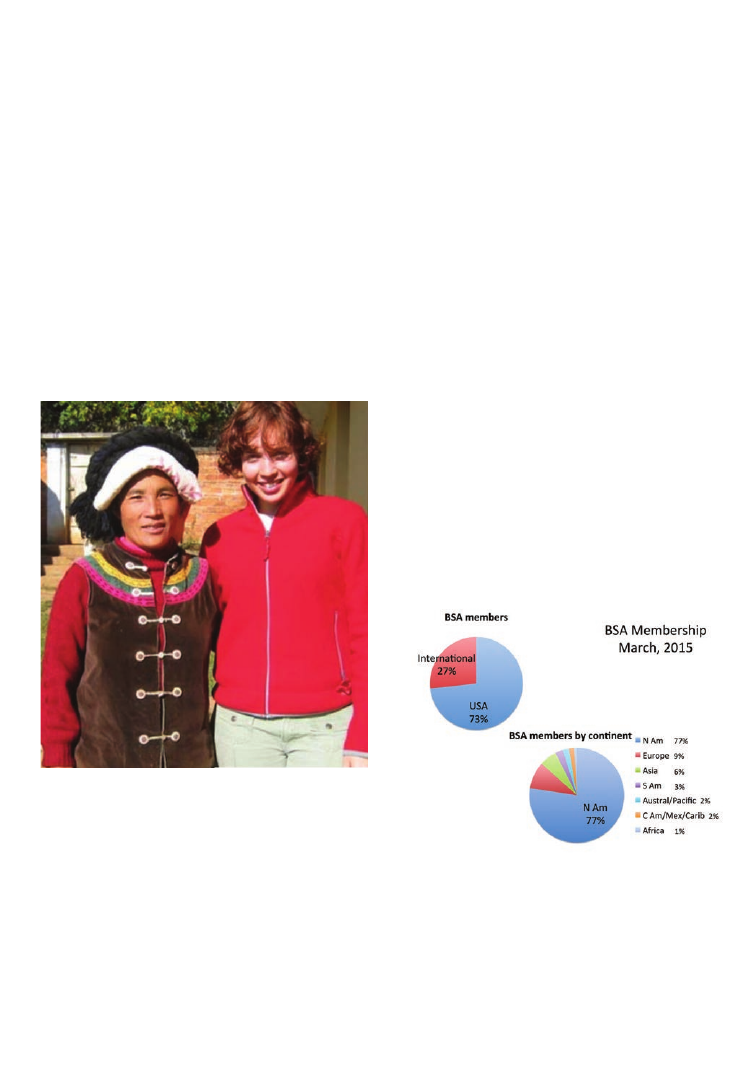
PSB 61 (4) 2015
122
the New York Botanical Garden on the origin
of domestication of eggplant. As a grad stu-
dent, Rachel was a student representative on
the BSA Board of Directors. She continued
research on the genetics of domestication as a
postdoc and is now an AAAS Fellow working
as an intern at the National Science Founda-
tion. Both Yao-Wu and Rachel attribute their
choice of career track and initial successes
to the opportunities made available to them
through this international exchange program.
For both of them, participation in, and sup-
port from, the BSA also helped launch their
careers.
Figure 3. Rachel Meyer with Nuoso woman in
Sichuan, China (2003).
As I considered what mark I might be able
to make as President of the BSA, I wondered
how representative my experiences were
among BSA members and if there was any-
thing the Society could do to advance interna-
tional collaboration in science and education.
In an effort to quantify this, with the help of
Membership Director Heather Cacanindin,
I asked members to fill out short, five-ques-
tion surveys about their experiences with in-
ternational collaboration. With background
information from the membership directory,
I devised three questionnaires: one for pro-
fessional botanists living in the United States,
one for students, and one for international
members. The surveys also provided an op-
portunity for members to comment individ-
ually. I will present the results of the surveys
here and have forwarded the results, along
with the many comments, to the BSA Com-
mittee on International Affairs.
For a little background, I sorted the mem-
bership lists to see what our international
membership looks like. While our member-
ship base is still mostly from the U.S., 27% of
our members are from other countries. Our
neighbors to the north [Canada] account
for another 4%, leaving 23% from outside of
North America (Figure 4). Most of the re-
maining are from Europe, Asia, and South
America.
Figure 4. BSA international membership.
A total of 234 BSA members answered the
survey, including 152 U.S. professionals, 48
foreign members, and 34 students. In each
survey, most questions asked about interac-
tions that had occurred in the last few years
(2012-2015), in order to keep the answers
Society News
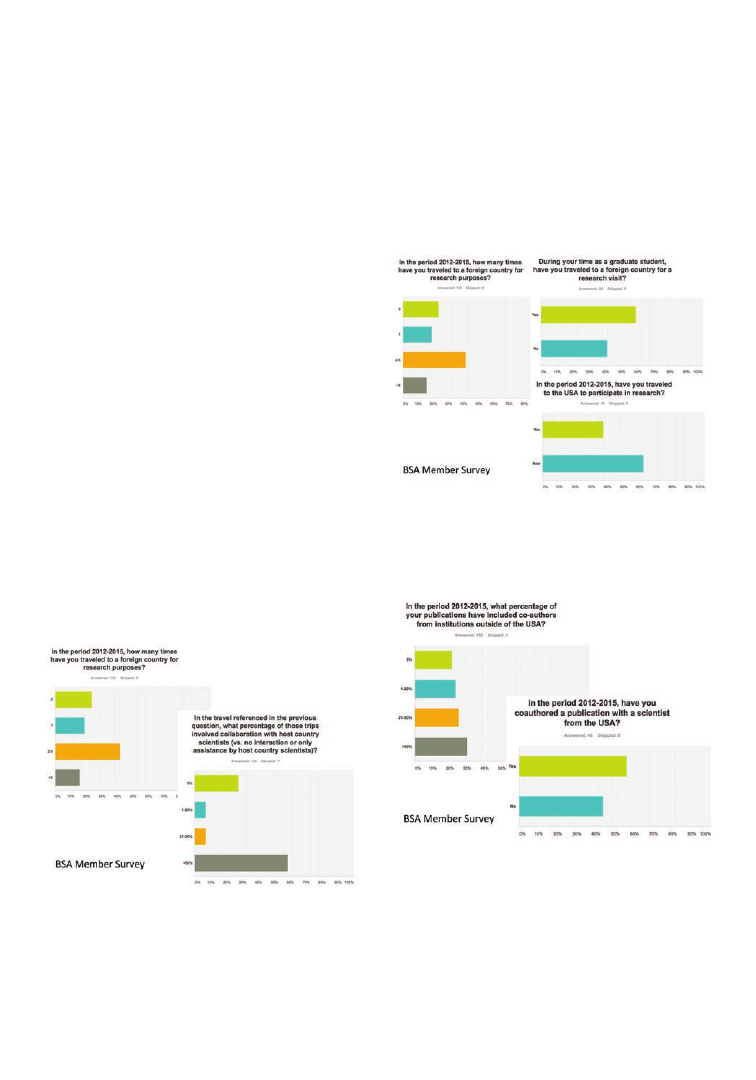
PSB 61 (4) 2015
123
from respondents of different ages compa-
rable. Bear in mind that, while many mem-
bers responded, this is not a scientific survey
and there may be biases inherent in whether
members responded or not and in how they
interpreted the questions.
The first questions in each survey asked about
frequency of travel. Over 75% of professional
members from the U.S. had traveled to a for-
eign country for research purposes in that in-
terval, with a mode of two to five trips in the
designated time period (Figure 5). Of those
trips, approximately 75% involved collabo-
ration with host country scientists. In con-
trast, fewer than 40% of foreign members had
traveled to the U.S. to participate in research
(Figure 6). Nearly 60% of our student mem-
bers had traveled to a foreign country for a
research visit. I am impressed with the level
of international collaboration among society
members in the U.S., but perhaps we could do
more to encourage our foreign members to
visit our labs as part of our international col-
laborations.
Figure 5. International collaboration of BSA
members as measured by the number of times trav-
eled to a foreign country for research purposes (0, 1,
2-5, or >5) and the percentage of trips that involved
collaboration with scientists from the host country
(0%, 1-20%, 21-50%, >50%).
Our U.S. professional members also actively
engage foreign collaborators in their research
publications, with nearly 80% publishing with
co-authors from outside the U.S. during the
last 3 years (Figure 7). Nearly one third of
these members shared authorship with for-
eign scientists on half or more of their papers!
Figure 6. BSA members’ collaborative travel
history.
Figure 7. BSA members’ collaborative publica-
tions publications measured by the percentage
of publications with international co-authors
(0%, 1-20%, 21-50% or >50%) and occurrence
of international co-authors (yes or no).
Slightly over half of our foreign members have
published with scientists from the U.S. during
Society News
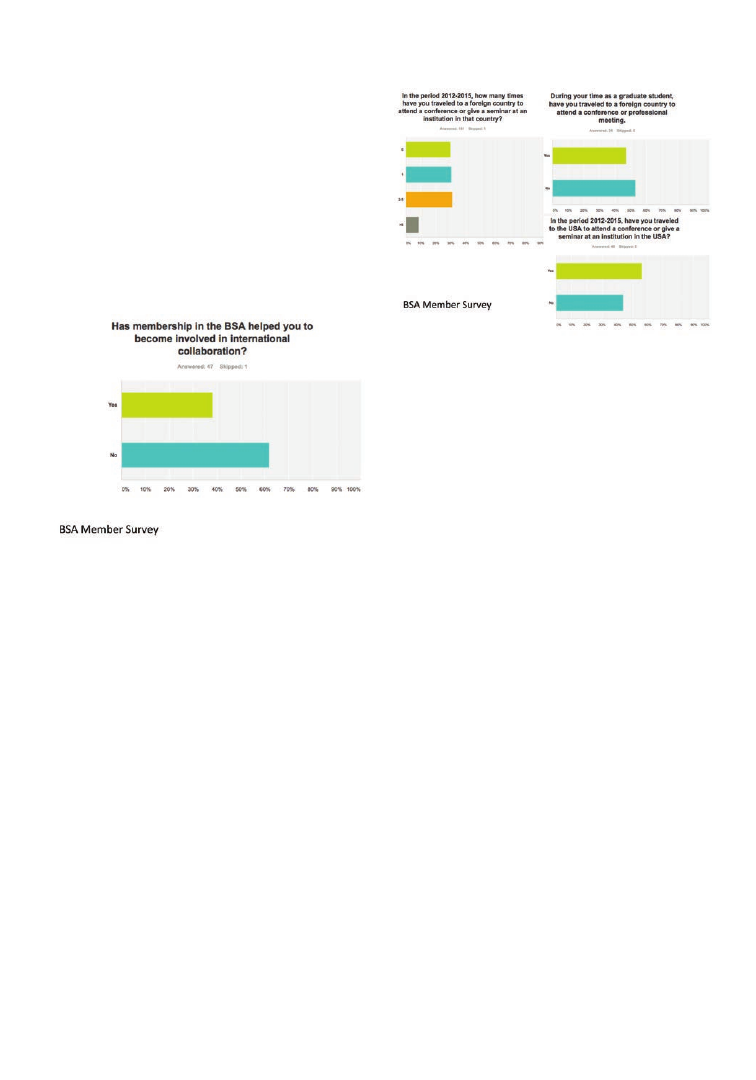
PSB 61 (4) 2015
124
that same interval. One of the frequent com-
ments from foreign members was that they
joined the BSA to take advantage of oppor-
tunities for collaboration with scientists in
the U.S. However, in response to the survey,
over 60% of foreign members said that BSA
membership has not helped them to become
involved in international collaboration (Fig-
ure 8). I believe the BSA can do more to foster
these interactions
.
With many members thinking about attending
the International Botanical Congress (2017 in
Shenzhen, China), I was interested in mem-
bers’ participation in international confer-
ences outside of the U.S. Approximately 70%
of U.S. professional members have attended
one or more international conferences in the
past 3 years and more than half of foreign
members have traveled to the U.S. to attend a
conference during that time (Figure 9). I was
impressed to see that nearly half of our stu-
dent members had attended a conference in
a foreign country during their time as a grad
student.
The value of international research exchang-
es is undeniable. A brief visit can be valuable
Figure 9. International travel to conferences by
BSA members including times traveled (0, 1,
2-5, >5) and occurrence of travel by U.S. profes-
sional members and foreign members (yes or no).
for establishing contacts and emerging collab-
orations, but having time to work together is
often essential for collaborations to fully de-
velop. In our survey, nearly two thirds of all
U.S. professionals report that they, or some-
one in their lab, has participated in a research
exchange, either hosting a foreign scientist or
being hosted in a foreign institution (Figure
10). More than half of international members
report participation in similar exchange with
a U.S. institution. Unfortunately, fewer than
15% of our students have had that opportunity.
Having the opportunity for international col-
laboration is a particularly valuable part of
graduate student development. There is no
better way to understand the impact of inter-
national collaboration than to experience it
oneself. I was pleased by the response to the
student survey to learn that two thirds of the
respondents have been encouraged by their
advisors to take advantage of opportunities
for international collaboration (Figure 11). In
addition to research exchanges, opportunities
for foreign travel for special training or educa-
tional opportunities are available for students
(e.g., Organization for Tropical Studies cours-
Society News
Figure 8. BSA membership’s ability to help in
international collaboration.
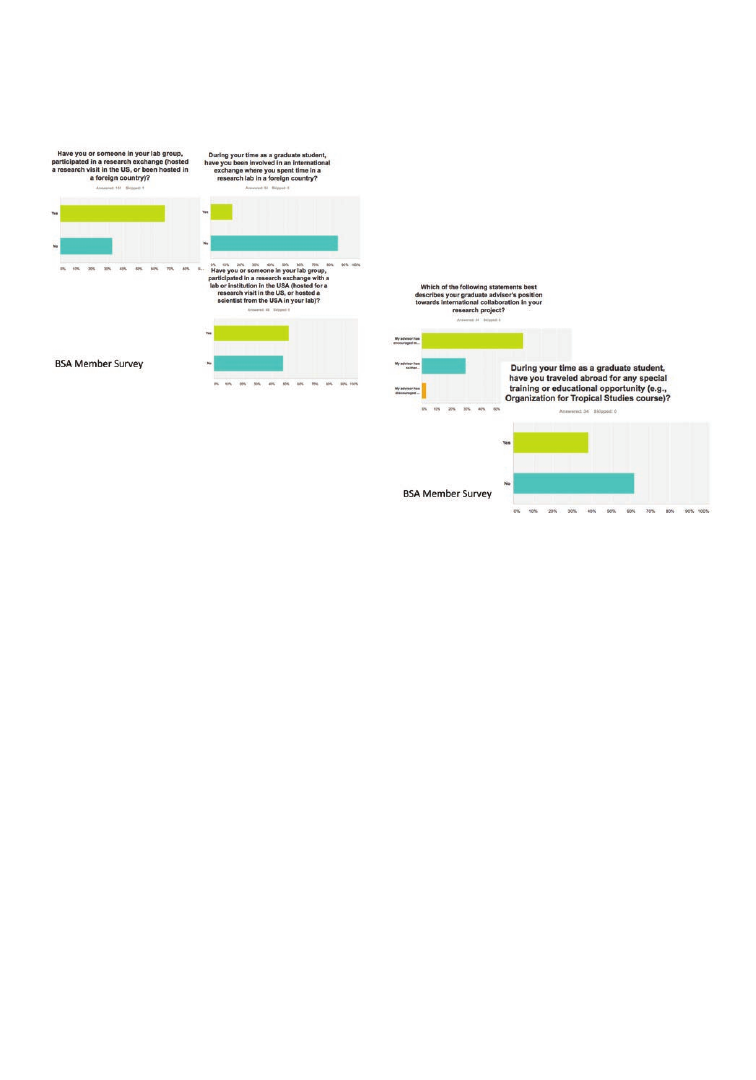
PSB 61 (4) 2015
125
es). Nearly 40% of student respondents have
taken advantage of such opportunities.
Figure 10. BSA members’ experience with re-
search exchanges, including participation of U.S
professional members (yes or no), graduate stu-
dents (yes or no) and foreign members (yes or no).
Increasingly, science is an international en-
terprise in which the network of connections
throughout the world can, if we choose to take
advantage of it, enhance everything that we
do as individual scientists. International col-
laboration in science and education seemed
to come naturally to me, but I realize that not
everyone has had the same opportunities that
I have had or has been encouraged to take ad-
vantage of them when they do occur. This is
where I think there is a role that the BSA can
play to help promote and facilitate interna-
tional cooperation in research and education.
What can the BSA do? In keeping with the
rapid globalization of botanical research,
the Society should do more to embrace a
leadership role in botanical research and
education worldwide. I think there are-
several things we can do to achieve this:
• Actively grow our international membership
• Partner with botanical societies in other
countries
• Provide a clearinghouse for information on
opportunities in research and education
• Promote international exchange and training
programs for students
• Facilitate contacts among botanists with
common interests
• Encourage member participation in interna-
tional conferences
I was struck by the survey comments from
international members indicating that they
hoped membership in the BSA would lead to
research connections, but also by the results
that show membership has fostered such col-
laboration for relatively few of them. If we can
help our members to connect and build their
own international networks, we can make a
difference in our science and in the careers of
those who practice it.
Reflecting back on that long microbus ride in
the Peruvian Andes, I realize that the personal
friendships I have made and the connection
to places and their histories have created em-
pathy for the issues confronting countries and
cultures around the world. The experiences
have not just made me a better international
botanist, but a better international citizen.
Society News
Figure 11. BSA members’ levels of encourage-
ment for international collaborations.

PSB 61 (4) 2015
126
Public Policy Notes
The BSA Public Policy
Quarterly
T
his year the BSA Public Policy Commit-
tee has been hard at work trying to bring
policy awareness and engagement to the BSA
membership. We surveyed members of the
BSA during Spring 2015 to understand how to
better provide our membership with the pol-
icy updates they need. We received responses
from 195 BSA members!
As a result, we found that a majority of you
want to be more involved in Public Policy, but
are unsure what our committee does and/or
how to become more engaged (Figure 1). As
a follow-up to your survey responses, we’ve
summarized our findings in this edition of the
Plant Science Bulletin. Here, we provide infor-
mation about the Public Policy Committee,
how to become more involved, and a sneak
peek at upcoming changes we have proposed,
including a new funding opportunity!
As for all BSA committees, the mission of the
BSA Public Policy Committee is outlined un-
der section XII of the society policies. The
Figure 1. Awareness of the BSA Public Policy
Committee.
Public Policy Committee is broadly defined,
but generally charged with “addressing is-
sues… to effect change, educate and influence
decision makers, and provide input from the
BSA perspective on public policy documents,
strategic plan documents from federal agen-
cies, and reports requesting input from plant
biologists.“ We work closely with other soci-
eties regarding policy, advise the BSA Board,
encourage members to present botany to the
public (including legislators and the general
public), and provide policy impact resources
for new activities to the BSA Board.
In order to make our impact more visible to
membership, we have taken the results from
our survey to heart and correspondingly up-
dated our activities.
How Often Would You Like to Be
Informed About BSA Public Polic
Activities?
A majority of you indicated that you would
like to be contacted either monthly (35%) or
quarterly (45%) regarding updates from the
Public Policy Committee, and we’d like to ex-
By Marian Chau (Lyon Arboretum Universi-
ty of Hawai‘i at Manoa) and Morgan Gostel
(George Mason University),
Public Policy Committee Co-Chairs
Society News

PSB 61 (4) 2015
127
plain how to get the best of both worlds: by
reading this quarterly column in the PSB and
signing up for bimonthly AIBS Public Policy
Reports at http://www.aibs.org/public-poli-
cy-reports/ (Figure 2)! The BSA Public Policy
Committee works closely with AIBS and, as a
result, our policy actions are often linked to
updates in the AIBS reports.
Figure 2. BSA members receiving AIBS updates.
In addition to the survey results we’ve pre-
sented here, we received a huge number of
recommendations from members regarding
activities we can pursue, and we’re working
on bringing more things into the fold as we
speak (Figure 3).
Figure 3. Policy activities of interest to BSA
members.
Do You Have Any
Recommendations for BSA Public
Policy Committee Activities?
Your top five responses included:
• Federal funding for basic botanical re-
search
• Cultivate ties with other groups
• Promote botany through STEM education
• Threatened and endangered species listing
and conservation
• Loss of university botany departments and/or
herbaria
In response to these comments, some projects
that are in progress include developing a Policy
website, helping to draft collaborative work with
other groups to inform conservation legislation
that will go up for a vote in Congress, showcas-
ing Public Policy activities from our member-
ship, and the introduction of a new public policy
award.
We received contact information from 20 BSA
members (>10% of respondents!), and we are
contacting these individuals for Public Policy
Quarterly guest columns to showcase their
policy activities. If you are interested in pre-
paring a guest column, please contact us (see
below)!
In the meantime, be sure to apply for the
fourth annual BSA Public Policy Award to at-
tend Congressional Visits Day in Washington,
DC (include link when the application form is
complete), due January 25, 2016!
As always, we welcome any news, ques-
tions, or information regarding public pol-
icy news in botany. Please contact either
Marian (mmchau@hawaii.edu) or Morgan
(gostelm@gmail.com).
Society News

PSB 61 (4) 2015
128
Economic Botany Notes
Extended Economic Botany
Avenues at the BSA
E
conomic botany is a broadening section
of the BSA, encompassing a myriad of
disciplines, and often providing an important
link between basic and applied research. At
this year’s Botany conference in Edmonton,
the Economic Botany section co-sponsored*
a well-attended multidisciplinary sympo-
sium, “Underutilized Crops for Secure and
Green Futures,” organized by section mem-
bers Nyree Zerega, Rachel Meyer, and Allison
Miller. Along with ten section talks and six
posters, the presenters explained the utility
of botanical resources to improve livelihoods,
serve as innovation platforms, impact ecology,
and recast our understanding of humans that
may all influence policy or genetic resource
development.
Following an introduction by Dr. Zerega high-
lighting the importance of underutilized crops
as an important—but largely untapped—
*
Support of the symposium was given by North-
western University, ASPT/BSA Systematics Section,
and BSA Genetics, Tropical Biology, and Economic
Botany sections.
source of plant genetic resources and the need
for more basic research on these species, at-
tendees heard six talks spanning the range
of disciplines represented by the BSA. Ear-
ly morning talks covered a study combining
forest ecology with ethnobotany to investigate
the impact of pre-Columbian management on
ecosystems, an analysis of the increasing ho-
mogeneity of the global food supply and pro-
posals for increasing crop diversity and food
security, and an investigation into crop wild
relatives at the intersection of economic bota-
ny, plant breeding, and systematics.
Late-morning talks included phylogenomics
and pollination biology of an underutilized
tree crop genus with a discussion of how ba-
sic research can be leveraged to promote the
development of underutilized crops, an over-
view of the African Orphan Crops Consor-
tium and the ambitious collaboration aiming
to develop genomic resources for 100 crops
and train African crop breeders to use them,
and finally an exploration of local adaptation
in amaranths, which contain both underuti-
lized crops and weeds, using phylogenetic and
population genomic tools.
Section posters ranged from showcasing ap-
pealing traditional plant uses for health and
for food packaging [Nepenthes can be a wrap-
per for sticky rice! (Schwallier et al.)] to tem-
perature tolerance phenotyping of crops and
phytochemical medicinal activity. Oral pre-
sentations included developmental, nutrition-
al, and ecological impact analyses of new and
underutilized foods and fodders. Fieldwork
and collection analyses of rice and chickpea
helped to reset ideas of adaptation trends.
By Elliot Gardner (Northwestern University
and Chicago Botanic Garden) and Rachel S.
Meyer (New York University)
Society News
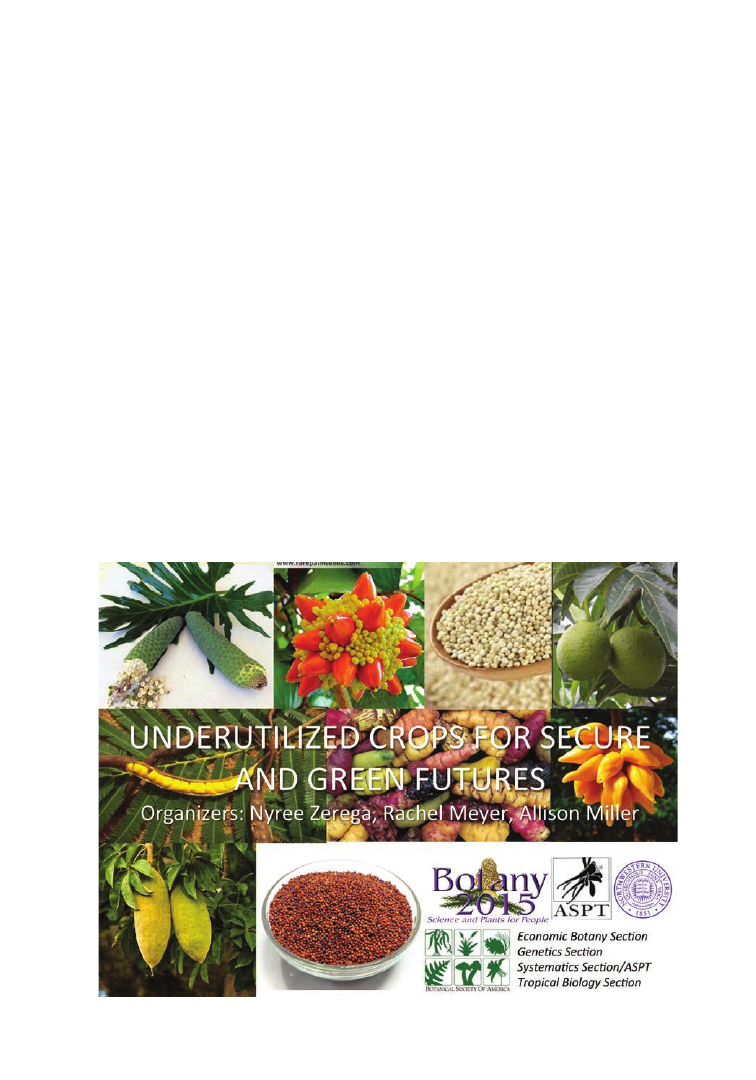
PSB 61 (4) 2015
129
New morphometric methods enabled infer-
ence of functional diversity. Geospatial collec-
tion assessment was used to set priority col-
lection areas for major crops. Extensive tribal
ethnobotanical databases were compared to
assess completeness.
Although the Economic Botany section is
small, its scope is great, bringing together re-
searchers from a wide variety of disciplines—
including systematics, genomics, phyto-
chemistry, ecology, ethnobotany, population
genetics, and policy—united by the study of
economically important plants. To address
the growing need to connect our section with
various disciplines and agencies, we have cre-
ated a new Community Relations Officer. We
have kept our section dues flat to encourage
broad participation in our section. We also
encourage students doing multiple- or in-
ter-disciplinary science to apply for Economic
Botany section travel awards and present at
the next meeting.
For more information, please contact either
Elliot (egardner@u.northwestern.edu) or
Rachel (rm181@nyu.edu).
References
Schwallier, Rachel, et al. 2015. Traps as treats: a tradi-
tional sticky rice snack persisting in rapidly changing
Asian kitchens. Poster from Botany 2015. http://2015.
botanyconference.org/engine/search/index.php?-
func=detail&aid=70.
Society News
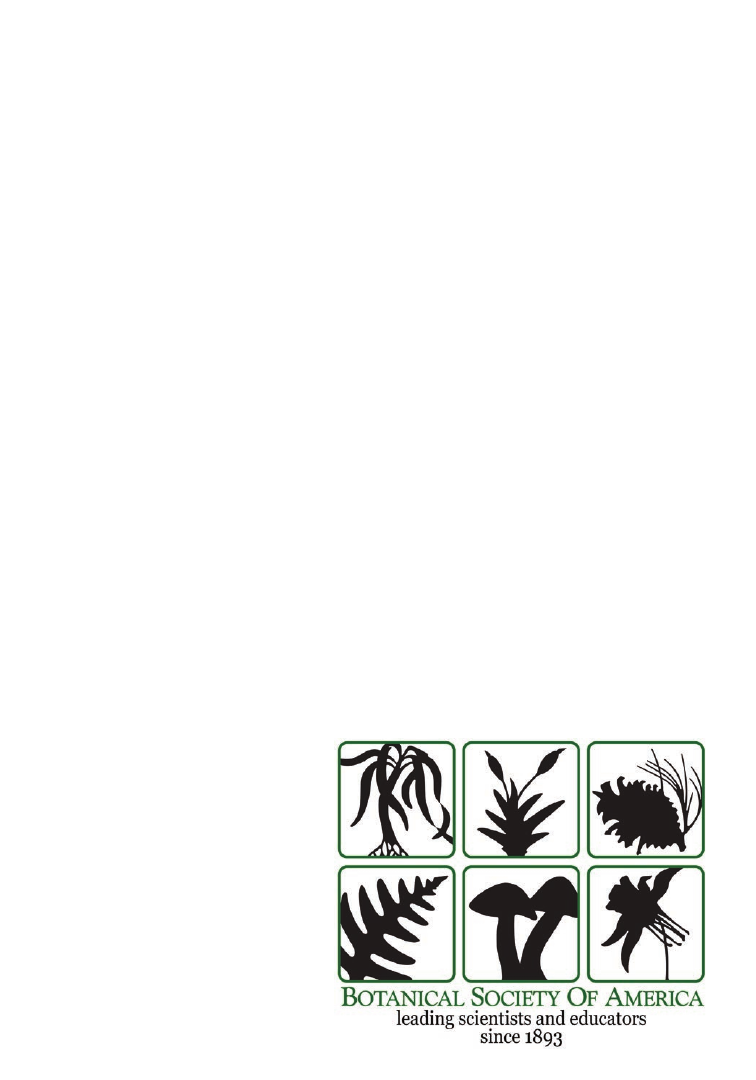
PSB 61 (4) 2015
130
Upcoming Award Deadlines
February 1st
• BSA Awards - General
• Darbaker Prize
• BSA Public Policy Award
March 1st
• BSA Student Travel Awards
• PLANTS Grants
March 15th
BSA Awards - General
• Distinguished Fellow of the Botanical Society
of America
• BSA Emerging Leader Award
• Charles Edwin Bessey Teaching Award
• BSA Corresponding Members
• Grady L. Webster Structural Botany Publica-
tion Award
• BSA Awards - Students
• BSA Young Botanist Awards
• BSA Graduate Student Research Awards
• BSA Undergraduate Student Research Awards
• Genetics Section Graduate Student Research
Awards
April 1st
• BSA Awards - General
• Jeanette Siron Pelton Award
April 10th
• Pteridological Section & American Fern So-
ciety Student Travel Awards
• TRIARCH “Botanical Images” Student Travel
Award
• Vernon I. Cheadle Student Travel Awards |
Developmental & Structural Section Student
Travel Awards
• Ecological Section Student Travel Awards
Economic Botany Section Student Travel
Award
• Genetics Section Student Travel Awards
The BSA has entered the awards season! Please visit http://botany.org/home/awards.html
for further information about the following awards as well as more information about BSA awards.
Society News

131
ARTICLES
Information about NSF Programs,
Policies, and Proposals:
What, Where, Why, How?
T
he scientific community always has
many questions about the Nation-
al Science Foundation (NSF); its programs,
funding applications, and proposal and re-
view process; and how things work in gen-
eral. While these items are covered in vari-
ous places on the NSF website (http://www.
nsf.gov), finding them can be challenging,
and searching requires some knowledge of
what terms to use. The NSF website is con-
stantly being updated and new functions
often appear to help you in your searches.
To keep researchers informed, NSF offers
“NSF Days” (http://www.nsf.gov/about/
congress/nsfdays/index.jsp) in various sites
around the country each year. In addition,
Program Directors (or Program Officers as
used in the Proposal and Award Policies and
Procedures Guide [PAPPG]) provide infor-
mation sessions at many professional society
meetings, as did the three authors at Botany
2015. We hope this short orientation based on
our information session this past July will help
researchers obtain the information they need
more easily.
About NSF (The “What”)
The NSF is a federal agency, and as such, its
budget and many of the priorities for the
agency are determined by the U.S. Congress,
the Office of Science and Technology Policy
(OSTP), and the President’s budget request
through the Office of Management and Bud-
get (OMB). For the most part, the distribution
of budget funds within NSF has been deter-
mined by the NSF Director’s Office and senior
management (Assistant Directors who are
the heads of the various Directorates at NSF).
They discuss the various policies and priorities
to be addressed with funding streams, but in
recent times, the U.S. Congress has put some
limitations on how funds are to be distributed
inside NSF. For example, Congress has deter-
mined funds for the Major Research Instru-
mentation Program. You can find the NSF
By Judith E. Skog
Sedimentary Geology and Paleobiology,
Earth Systems GEO
Roland P. Roberts
Biological Infrastructure, BIO
Joe T. Miller
Environmental Biology, BIO
National Science Foundation, Arlington, VA

PSB 61 (4) 2015
132
budget requests and final budgets at http://nsf.
gov/about/budget/.
We point this out because program directors
typically are not the ones determining where
resources go, so arguing your case for spend-
ing priorities at their level might not be the
place to direct this issue. If a program director
notes that he or she can’t make this decision,
please believe him or her! It should also be
noted that OSTP will often form Interagency
Working Groups to address issues that span
government agencies (one was formed on
plant genome issues and one was addressing
Scientific Collections). At times, the response
to these working group findings could be new
programs or initiatives at NSF (e.g., the Plant
Genome Research Program and the Advanc-
ing Digitization of Biological Collections pro-
gram). In addition, the National Academy of
Sciences (NAS) often forms special commit-
tees to examine research issues, or the sci-
entific community will hold workshops that
result in reports on special areas of research
needing attention. NSF may use these reports
It is also important to understand that NSF
is overseen by the National Science Board
(NSB), and that body determines policies for
NSF. The NSB, for example, recently released a
report on reducing the workload for Principal
Investigators (http://www.nsf.gov/pubs/2014/
nsb1418/nsb1418.pdf) in which preliminary
proposals were recommended as a mechanism
that should be tested. The “About NSF” web
page (http://www.nsf.gov/about/) provides a
lot of information, including NSF’s current
priorities, strategic plan, and the composition
of the NSB. Being familiar with these items
can help you understand the goals of many of
the programs within NSF and to whom you
should address concerns about opportunities
for support.
Science and engineering research and educa-
tion support at NSF is organized into seven
directorates under the Office of the Director:
• Biological Sciences
• Geosciences
• Computer and Information Science and
Engineering
• Engineering
• Social, Behavioral and Economic Science
• Education and Human Resources
• Mathematical and Physical Sciences.
Within directorates, organization varies;
some are divided further into divisions, clus-
ters or sections, offices, virtual activities, spe-
cial activities, or other units that make sense
for their size and activities. This structure may
seem to be narrowly divided; however, there is
opportunity for exchange of ideas, co-review-
ing, and collaboration among the entities.
Be assured, the scientists working at NSF rec-
ognize the collaborative nature of research
and strive to provide the best reviews of the
science within each program and across what
may appear to be a restrictive and narrow
focus of the various programs. We note this
Researchers often think
they can only look to
their “home director-
ate” for support, but it
is important for every-
one to peruse programs
across NSF.
as priorities for the foundation are consid-
ered. Many professional societies (e.g. AIBS,
AAAS, as well as BSA) have public policy of-
fices or committees, and they can be valuable
resources to help one understand how the sci-
ence funding policies are determined.
Articles

PSB 61 (4) 2015
133
because researchers often think they can only
look to their “home directorate” for support,
but it is important for everyone to peruse
programs across the foundation. For exam-
ple, the Major Research Instrumentation pro-
gram is managed through the Office for In-
tegrative Activities (http://www.nsf.gov/dir/
index.jsp?org=OIA) under the Office of the
Director, and some international activities are
supported through the Office of Internation-
al Science and Engineering (http://www.nsf.
gov/div/index.jsp?div=OISE).
Although the science is overseen by the var-
ious directorates/programs, the actual finan-
cial part is overseen by the Office of Budget,
Finance, and Award Management. The di-
vision of this office you will most likely deal
with is the Division of Grants and Agreements
(DGA), since DGA actually makes the awards
recommended by the science divisions. Your
sponsored research office (SRO) is probably in
close contact with DGA and its policies, and
you should consult your SRO about budget is-
sues when preparing proposals or you should
consult your grants officer if you have ques-
tions about an award. Program directors will
answer questions about the science for pro-
posals and awards.
A program director will typically be your pri-
mary point of contact at NSF, and it is worth-
while to know there are various ways program
directors are employed at NSF. There are pro-
gram directors who are permanent employees
whose only job is at NSF. Then there are cat-
egories of temporary staff who serve shorter
terms at NSF. Rotating program directors may
come for 1 to 3 years through (1) the Intergov-
ernmental Personnel Act (IPA), where these
people retain their institution employment
and NSF pays the institution for their services,
(2) Visiting Scientists who take leave from
their university and are paid by NSF, and (3)
temporary federal employees who resign oth-
er jobs and are full time for a limit of 3 years
at NSF. There are also “experts” hired for spe-
cial tasks (e.g., to fill in short-term within pro-
grams on a part-time basis). Rotator positions
are an opportunity for others to learn more
about NSF and to bring their special scientific
expertise to the foundation. Announcements
appear regularly for these openings, and they
are posted on the NSF website on the director-
ates’ web pages and on USAJOBS.
Information on Programs
(The “Where”)
Most likely, many of you as plant biologists
will be considering funding opportunities
through programs managed by the Director-
ate for Biological Sciences (BIO, http://www.
nsf.gov/dir/index.jsp?org=BIO), so we will
provide a brief overview of this directorate.
There are four divisions in the directorate: Bi-
ological Infrastructure (DBI), Environmental
Biology (DEB), Integrative Organismal Sys-
tems (IOS), and Molecular and Cellular Biol-
ogy (MCB). As you can see, the divisions ad-
dress research at the level of the cell and below,
the organism level, above the organism level,
and any research or program that provides in-
frastructure required for biological research,
including education from undergraduate to
postdoctoral researchers.
A program director will
typically be your primary
point of contact at NSF,
and it is worthwhile to
know there are various
ways program directors
are employed at NSF.
Articles

PSB 61 (4) 2015
134
We do not describe individual programs here,
because the goals, the criteria, and the em-
phasis can change from year to year. You can
find a list of upcoming funding opportunities
for BIO on nsf.gov (http://go.usa.gov/3WZsy)
and on the main BIO blog, BIO Buzz (https://
nsfbiobuzz.wordpress.com/programs/). You
should read the program description and so-
licitation that are the most recent versions be-
fore you begin work on any proposal. When a
solicitation has been replaced by a newer ver-
sion, there should be a note at the top of the
solicitation giving the newest number or not-
ing that it has been replaced. Be sure to check
for any indication of revision.
Some programs within BIO are collaborative
with other directorates or other agencies or
have other groups setting priorities. The Plant
Genome Research Program located in IOS,
for example, is developed based on plans pro-
duced every five years by a working group of
several governmental agencies (who were part
of the OSTP Interagency Working Group for
Plant Genomics mentioned above), and this
program’s priorities may change depending on
that plan. As another example, the BIO post-
doc program often partners with other direc-
torates to address a need for new researchers
to be trained as interdisciplinary scientists. If
there are no external partners in the postdoc
program, a group of program directors from
all the divisions within the BIO directorate
considers areas of need for new expertise in
a specific biological area of research and rec-
ommend this as an emphasis for the postdoc
program. These areas of emphasis generally
continue for five years.
Some additional items of note regarding BIO
programs: There are special programs that
have their own deadlines and requirements,
such as CAREER, OPUS, Genealogy of Life,
LTREB, Ecology of Infectious Diseases, Re-
search Coordination Networks, and Dimen-
sions of Biodiversity. These do not fall under
the same deadlines or requirements as the
core programs, even though they are funded
out of the same money as the core programs
(for a complete list of BIO active funding op-
portunities, visit http://www.nsf.gov/funding/
pgm_list.jsp?org=BIO&ord=date). Note that
DEB also has a small grant category that is
labeled at the preproposal stage as a project
whose budget is capped at 150K; this is for
projects that are smaller in scope and size.
So far, the funding rate for these DEB small
grants is slightly higher than for the rest of the
core grants. You can find further information
about small grants in the program solicitation
and information about the funding rates for
the small grants on the DEB blog (http://www.
nsf.gov/div/index.jsp?div=DEB).
Also remember that programs are not static
and the emphasis may change or there may
To gather additional infor-
mation and advice on BIO
programs, we recommend
you read the blogs from the
BIO divisions for analyses of
programs and funding rates,
news items about research,
statistics on awards, staff
profiles, and advice on vari-
ous programs:
• DEB blog (DEBrief):
http://
nsfdeb.wordpress.com
• IOS blog (IOS InFocus):
http://nsfiosinfocus.word-
press.com
• MCB blog:
https://nsfmcb.
wordpress.com/mcb-blog/
Articles

PSB 61 (4) 2015
135
be programs with defined limits to their ex-
istence based on budgets or new government
emphases. Once a special program reaches
its set duration, the research may be includ-
ed within core programs, the special program
may be redefined, or additional buy-in from
across NSF or other agencies may continue
the program with a different format or em-
phasis.
To gather additional information and advice
on BIO programs, we recommend you read
the blogs from the BIO divisions. The division
blogs are where you can find analyses of pro-
grams and funding rates, news items about re-
search, statistics on awards, staff profiles, and
advice on various programs such as CAREER:
• DEB blog (DEBrief): http://nsfdeb.word-
press.com
• IOS blog (IOS InFocus): http://nsfiosinfocus.
wordpress.com
• MCB blog: https://nsfmcb.wordpress.com/
mcb-blog
/
While most botanists seek funding from the
BIO directorate, as we said above, you should
look for funding opportunities throughout the
foundation. If you are developing computer
informatics that are of general use, check out
programs under the Computer and Informa-
tion Science and Engineering (CISE) director-
ate (http://www.nsf.gov/dir/index.jsp?org=-
CISE). The Geosciences (GEO) directorate
(http://www.nsf.gov/dir/index.jsp?org=GEO)
also includes programs that could be useful to
consider; if you are doing research in the po-
lar regions, check out Polar Programs (http://
www.nsf.gov/div/index.jsp?div=PLR); or if
you are studying fossils, read about the Sed-
imentary Geology and Paleobiology program
(http://www.nsf.gov/div/index.jsp?div=EAR).
For Education activities, such as REU sites,
new undergraduate efforts, graduate student
programs and education research, the Educa-
tion and Human Resources (EHR) directorate
(http://www.nsf.gov/dir/index.jsp?org=EHR)
is the place to look. If you are unsure about
where your specific research fits best, use the
NSF awards database to search for keywords
that describe your research. You may discover
programs that you had not considered previ-
ously.
Process and Policies
(The “Why”)
Program Directors are often asked why cer-
tain programs have different requirements or
review methods (e.g., panels, ad hoc review-
ers, a combination of these two, or no reviews
for certain categories). We call your attention
to a document that was produced after a Mer-
it Review Working Group analyzed a number
of issues at NSF with respect to workload,
the burden on the community, and the bur-
den on Principal Investigators: http://www.
nsf.gov/oirm/bocomm/meetings/nov_2011/
Merit_review.pdf. In this document, there are
a number of charts and graphs illustrating the
merit review challenges occurring in the past
decade. Of particular interest will be the last
two pages (pp. 25-26) where numerous sug-
gestions are made for ways to improve the re-
view process. Several of these are being tested
across NSF to see if they are effective.
For example, programs within DBI and MCB
have a single deadline per year, whereas DEB
and IOS require preproposals and then those
investigators who are invited to do so may
submit full proposals. Some GEO programs
are testing, having no deadlines, with propos-
als being accepted anytime. Other programs
limit the number of proposals that may be
submitted by a PI in a given time frame. Be
sure to visit the various directorate and divi-
sion web pages and the program pages and
solicitations to understand the deadlines, the
Articles

PSB 61 (4) 2015
136
goals and priorities, and the various required
documents for each program. You also need
to review carefully the PAPPG, which is the
general information source for policies and
procedures for all submissions to NSF in general.
Proposal Information
(The “How”)
Okay, you are now informed on how to tackle
programs and find the information you need
about them. Now we’ll discuss the proposal
process. Many good proposals are submitted
to programs, but what is a “good proposal”? A
good proposal is a good idea, well expressed,
with a clear indication of methods for pursu-
ing the idea, evaluating the findings, and mak-
ing them known to reviewers and others who
need to know.
However, just writing a good proposal does
not make it competitive within a particular
program. A competitive proposal is a good
proposal and it is appropriate for the program
and responsive to the specific requirements
of the program solicitation or announcement
(program summary). It also conveys some ex-
citement and innovation in the field of study;
therefore, you should always read and consid-
er all information about the program carefully
before you begin to write a proposal.
When reading a program summary and so-
licitation, focus on the goals of the program,
eligibility requirements, and other special
requirements and review criteria. Keep the
review criteria in mind as you think about
writing a proposal. Intellectual merit refers to
the ways in which the proposed activity will
advance science and engineering through re-
search and education. Broader impacts are the
broader scientific and societal impacts of the
project and its potential results. In addition
to these two overall criteria, look for special
review criteria for the program as described
in the announcement or solicitation. Often,
at the end of a solicitation, there is a section
called “Additional Review Criteria.” Be sure to
read solicitations thoroughly, as we find this
section is often missed. Every page of a solic-
itation provides important information for
preparing a competitive proposal. You may
want to ask someone for a copy of their suc-
cessful proposal—but remember that some
program announcements are reissued year-
ly or on a regular cycle, so the emphasis can
change. The award abstracts database (
http://
nsf.gov/awardsearch/
) is a good place to find
recently funded awards for a program to see
what the emphasis has been in recent years.
On the program web page, you will find a link
at the bottom for “Recent Awards in this Pro-
gram” that will quickly take you to the most
recent awards and save you from searching all
of the NSF awards database.
Identify your best research ideas for which you
have some preliminary data. Be sure you have
developed clear hypotheses and experimen-
tal procedures before you take the next steps.
Consider feasibility in a 36- to 60-month win-
dow and what assistance you will need, given
teaching and other time commitments. Think
carefully about the budget request and how
you would justify that request based on the
Often, at the end of a so-
licitation, there is a sec-
tion called “Additional
Review Criteria.” Be sure
to read solicitations thor-
oughly, as we find this
section is often missed.
Articles

PSB 61 (4) 2015
137
Commandments for a
Competitive NSF Proposal
• Thou shalt start early! Give yourself
enough time to check all the items and
consider the proposal for all the criteria.
Think carefully about the budget and that
it is well justified by the research program.
• Thou shalt address the NSF review cri-
teria thoroughly! Both intellectual mer-
it and broader impacts should be ad-
dressed and related to the project. This is
especially important when considering
the broader impacts, since there should
be some direct relevance for the research
in a societal context. To simply say you
will participate in an ongoing activity
at your institution is not enough; ex-
plain why your project is important for
that activity and why that activity is im-
portant for your project. Be as specific
about the broader impacts of the project
as you are about the intellectual merit.
• Thou shalt read the PAPPG and the pro-
gram announcement and solicitation!
Follow all instructions in these doc-
uments.
• Thou shalt get feedback on your proposal
from your colleagues! Proposals should
be cogent, appropriate, and justified.
Study the reviews carefully if you receive
them—for both awards and declines.
Anticipate criticisms and invite criticism
before you submit. Do not ask only the
people close to your field of research, but
ask someone who is not familiar with
what you are doing to provide comment.
If that person says something like “It was
OK,” don’t submit that proposal. If that
person says, “Wow, I had no idea your
work was so interesting,” send in the pro-
posal. Remember that when this project
is read in a panel, you will have at least
three people reading it and comparing it
to the other proposals within that pan-
el. If the two people who are outside the
specific area of your research don’t like it
because they don’t see the rationale or the
excitement of this research, their reviews
won’t be enthusiastic either. And you
need to convince a wide audience of peo-
ple that your work is important. Which
brings up the next commandment….
• Thou shalt not irritate the reviewers!
Be clear and concise and make it easy
for reviewers to understand all parts of
the project. Think like a reviewer be-
fore you submit the final draft. And, by
the way, do submit the final draft—not
the one with the comments inserted
into the text that say “This paragraph
needs work!” Yes, we have seen those.
• Finally, thou shalt contact your program
director! If questions remain about items
within the proposal, we are here to help.
We realize that not all the items in the doc-
uments we provide are clear to everyone,
and there are ways of interpreting pro-
gram announcements that require some
clarification. Don’t be afraid to write with
specific questions or to request a phone
conversation; it’s always best to prepare
your PD prior to a phone call. We can’t an-
ticipate all questions, and some answers
require a bit of research and discussion.
You will speed up the process by asking
the question or outlining the problem
and requesting time for a conversation if
the answer cannot be provided through
e-mail. Obviously, e-mail is preferred, so
we all have a record of the question and
the answer, and to maintain consistency
with decisions made within the program.
Articles

PSB 61 (4) 2015
138
proposed activities. Communicate with a pro-
gram director who can assist in determining
the project’s relevance for the program and
answer your questions.
Writing a Proposal
Read the PAPPG (http://www.nsf.gov/pub-
lications/pub_summ.jsp?ods_key=papp) for
guidance and instructions on proposal prepa-
ration and submission, and all criteria for the
proposal to be accepted by the system. The
guide describes the process for declinations,
returns, withdrawals, awards, and significant
items for grant administration. The require-
ments in this guide apply to all proposals
submitted to NSF, but remember, there may
be additional requirements or more restric-
tive requirements found within a program’s
solicitation or announcement. So, when com-
posing your proposal, first follow the PAPPG
and then apply any changes or additional con-
tent described for the program solicitation to
which you are responding.
Anticipate some frustration along the way.
If your proposal is declined and the reviews
and panel summary do not make clear why,
first look to see if there is a program director
(“PO”) comment on your proposal. If not, or
if this still does not address your concerns,
contact the program director once you have
thought carefully about the reviews and the
questions they raise. If awarded, follow up on
reporting and stay in touch with the program
about your accomplishments and publica-
tions. NSF is always eager to share PI research
and education outcomes on their website and
via social media.
A Note about Preproposals
Does our advice apply to preproposals where
these are required? Mainly, yes. Programs will
provide instructions for preproposals in the
announcement and there will be information
about preproposal submission. Typically, sim-
ilar instructions are included for preproposals
and proposals; however, since preproposals
are shorter, it is important to understand what
makes a good preproposal. In a preproposal,
reviewers look for excitement, significance,
rationale for the main idea, and a justification
that the methods proposed will answer the
question posed. The conceptual framework of
the main objectives and the specific aims for
the project must be clearly stated. And, as with
full proposals, the broader impacts should be
relevant for the project.
Final Bit of Advice
Stay up to date on NSF programs, deadlines,
jobs, and events by subscribing to the NSF
news feed, which you can find under the News
web page (http://www.nsf.gov/news/). At the
top of the page is a link to receive news by
email. When you subscribe, you can choose
how to receive news items, how often, and
which items you want to receive so you will
not be flooded with information not relevant
to you. In addition, you may want to read
the BIO blogs and follow NSF and BIO on
Twitter and Facebook (see http://www.nsf.
gov/social/). Being informed about critical
dates, changes in programs, new programs, or
changes in requirements or policies is the best
way to prepare and submit proposals that are
appropriate for a program at NSF.
Articles
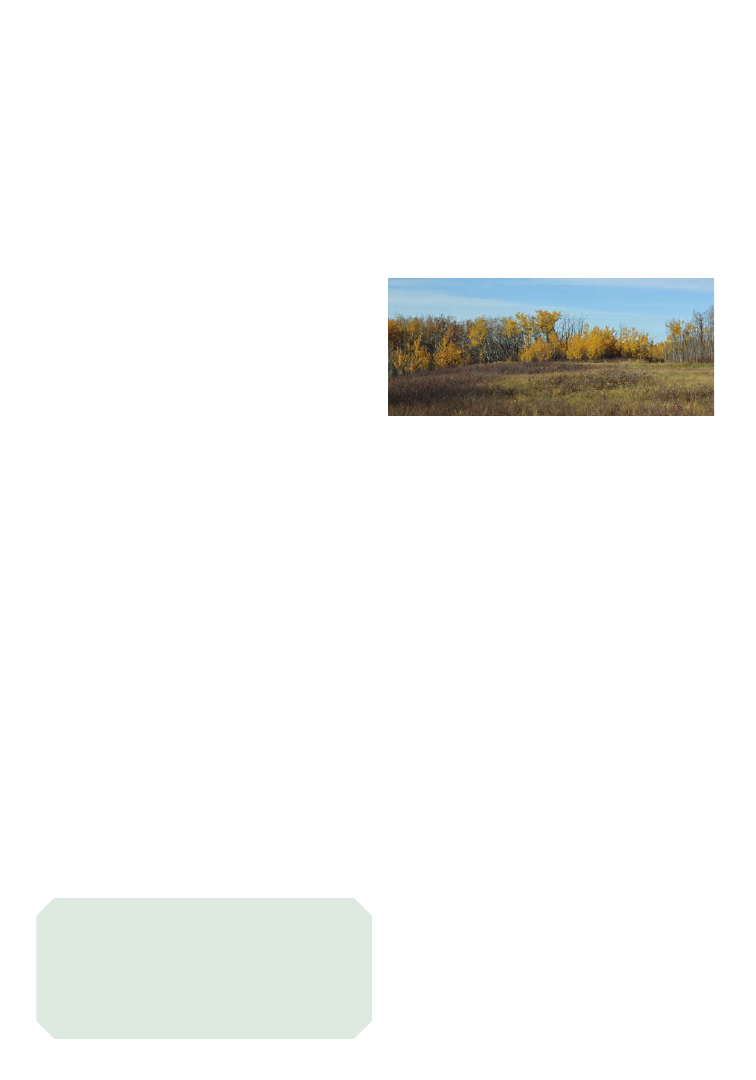
PSB 61 (4) 2015
Articles
139
Nisku Prairie: An Aspen Parkland
Remnant in Central Alberta,
Canada: Conservation Challenges
by Patsy Cotterill
Cotterill is an Edmonton botanist. She is a
steward of three protected areas in the aspen
parkland and boreal regions of Alberta,
Canada, and also volunteers with City of
Edmonton natural areas and parks.
I
n the Interior Plains of North America, as-
pen parkland extends as an arc some 200 to
250 km wide from the foothills of the Rocky
Mountains across the Canadian Provinces of
Alberta, Saskatchewan, and Manitoba. It is a
vegetation zone unique both to North Amer-
ica and the world, bounded in Alberta by the
boreal forest to the north and the grasslands
region to the south. It is so named because
it naturally consists of a mosaic of groves of
trembling aspen (Populus tremuloides) and
open grassland, dotted with wetlands in
low-lying areas. Its flat or undulating topog-
raphy is a legacy of glacial debris deposited at
the end of the last glaciation; silt from glacial
lakes, till from in situ glacier melting, wind-
blown sand dunes or glacial outwash from
meltwater channels. Grasslands developed in
the drier sites, woodlands in the wetter ones.
Aspen parkland proved ideal for European
settlement with its fertile soils. Today only 6%
of its original prairie is left, the rest consumed
by agriculture, the oil and gas industry and,
most recently, urban and suburban develop-
ment. Most of its remaining grasslands are
small, isolated, and few and far between.
Figure 1. Nisku Prairie landscape in October
2015, showing aspen groves and interspersed
grassland. (Photo credit: Charles Richmond)
Nisku Prairie is one such remnant (Figure 1).
Twenty-three acres in extent, it is an L-shaped
parcel of largely native grassland bordered
and intruded by aspen groves. It is situated
on the west-facing, gently terraced slope of
the Gwynne Outlet Channel, which is incised
about 20 m into the surrounding plain. This
broad, shallow valley was eroded when Glacial
Lake Edmonton discharged through it some
10,000 years ago. On the other three sides, Ni-
sku Prairie is bordered by a road and acreage
residences. The municipality of Leduc County
has preserved it as a municipal reserve, allow-
able under the Municipal Government Act of
Alberta, which requires that 10% must be set
aside as public land when private land is sub-
divided for development.
In 1993 a local acreage owner “discovered” the
prairie with its rich assemblage of native flora.
Ecologists from the Government of Alberta
and the University of Alberta testified to its
ecological value as a rare remnant, and Leduc
County was persuaded to beef up its protec-
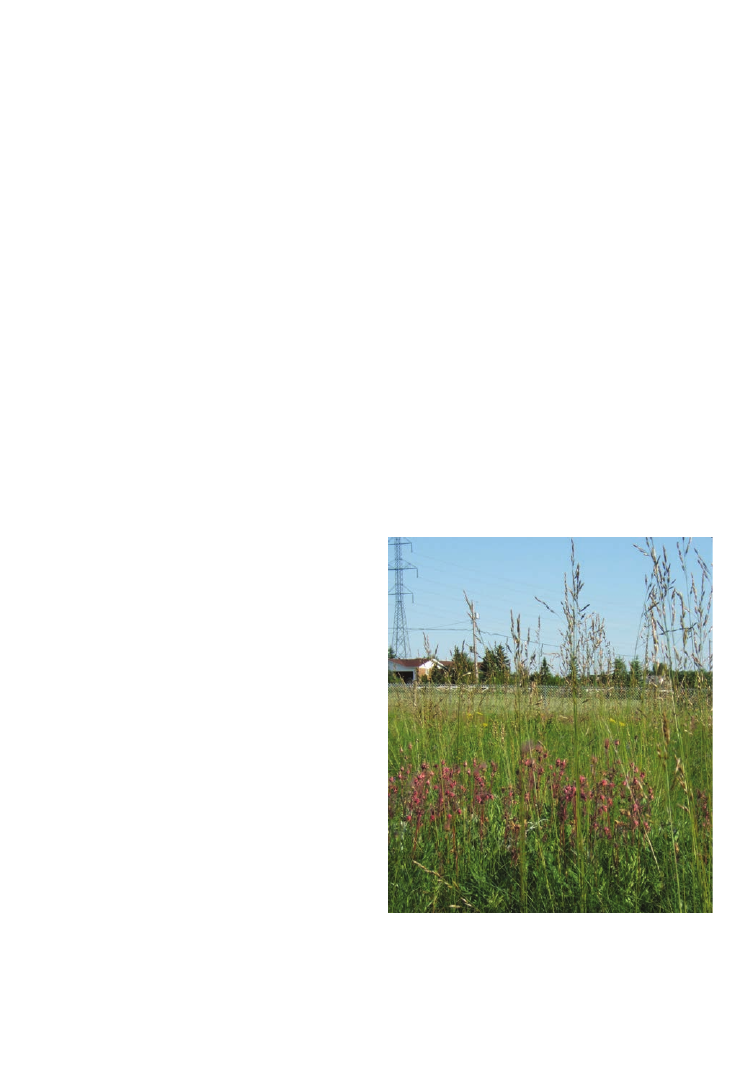
PSB 61 (4) 2015
Articles
140
tion of the reserve. With the approval of local
residents, the County staked out the boundar-
ies more carefully and erected a fence along all
but the western perimeter, along with a horse
gate for access, and appropriate signage. This
arrangement has been successful in keeping
out all-terrain vehicles, a major recreational
menace in rural areas, including supposedly
protected natural areas and reserves. On the
public side, a volunteer management commit-
tee was established. This cooperation was later
formalized in a Stewardship and Management
Agreement co-signed by Leduc County and
the Native Plant Council of Alberta, whose
local members contribute to the pool of vol-
unteer stewards.
A Diverse Grassland Flora
Small differences in topography, including
boulder outcrops, in soil type and moisture,
such as in shallow draws and west-facing
slopes, contribute to a diverse flora of over
180 species (including woodland species). The
dominant grass of the grassland component of
aspen parkland is plains rough fescue (Festuca
hallii), one of three rough fescue species that
comprise what was formerly considered a sin-
gle entity, the Festuca scabrella complex, now
recognized as the provincial grass emblem be-
cause of its ecological importance and cultural
significance as the basis of the ranching indus-
try in Alberta. Nisku Prairie’s large cover of
rough fescue grass (F. hallii) indicates conclu-
sively that it is an original grassland remnant,
as this grass does not regenerate once land has
been plowed. Somewhat enigmatically, which
seems to be true of many of the prairie rem-
nants in our area, Kentucky bluegrass (Poa
pratensis), considered to be an introduced
species, is also a major component. Nisku
Prairie’s soils belong to the Chernozemic and
Solonetzic orders, the former releasing Ca
2+
ions from weathering of the glacial sediments,
the latter Na
+
ions, with consequences for soil
structure and vegetation. Large patches of in-
termediate oat grass (Danthonia intermedia)
and mat muhly (Muhlenbergia richardsonis)
indicate solonetzic soils; in small spots where
the solonetz develops into hard pans lacking
vegetation, thickspike wheatgrass (Elymus
lanceolatus subsp. lanceolatus) is present.
(Many of our northern prairie remnants oc-
cur on solonetzic soils because they were dif-
ficult to cultivate; this protection does not un-
fortunately apply to rapid urbanization.)
Our most prized grass is Canadian ricegrass
(Piptatheropsis canadensis), a relative rarity
in Alberta. Among the eight species of sedge
(Carex) recorded, woolly sedge (Carex pelli-
ta) and graceful sedge (C. praegracilis) appear
to be the most prominent, especially in the
moist solonetzic areas. Dudley’s rush (Juncus
dudleyi) is common throughout the grassland
(Figure 2).
Figure 2. Plains rough fescue and three-flow-
ered avens. (Photo credit: Patsy Cotterill)
Among our typical herbaceous species of the
grassland are prairie crocus (Anemone patens),
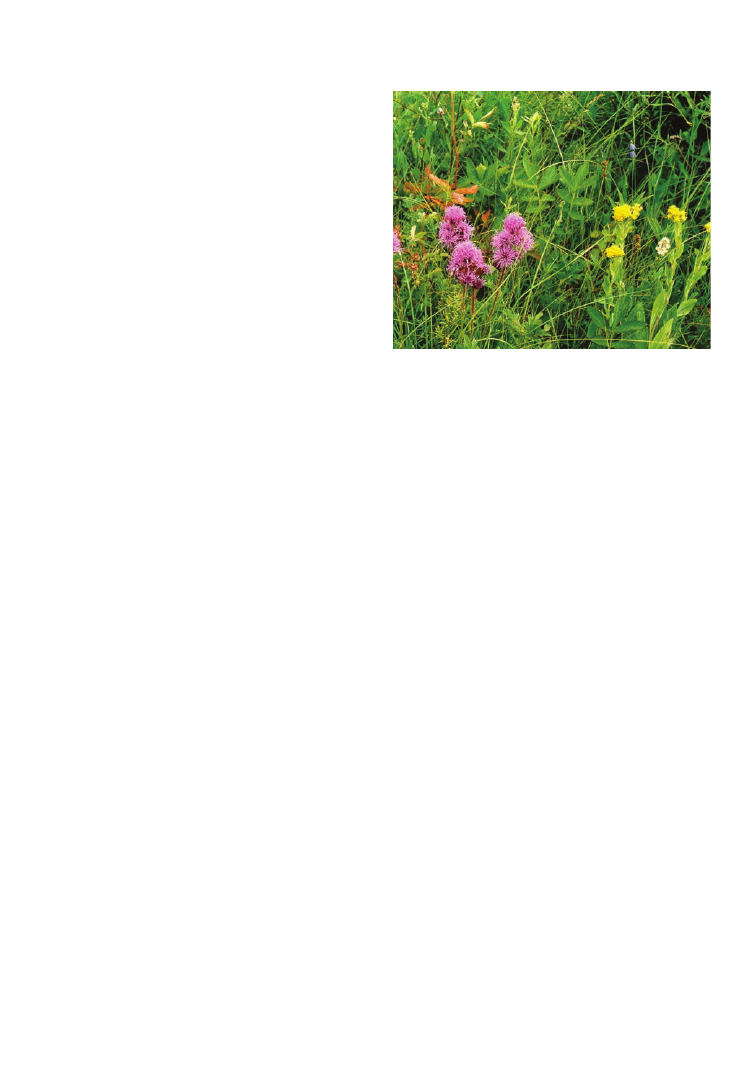
PSB 61 (4) 2015
Articles
141
much esteemed as a harbinger of spring when
it blooms in early May, three-flowered avens
(Geum triflorum), two buttercups, prairie (Ra-
nunculus rhomboideus) and heart-leaved (R.
cardiophyllus), and heart-leaved alexanders
(Zizia aptera). A succession of flowers occurs
throughout June and July, including two spe-
cies of Arnica, slender blue beardtongue (Pen-
stemon procerus), golden-bean (Thermopsis
rhombifolia), field mouse-ear chickweed (Cer-
astium arvense), northern bedstraw (Galium
boreale), and veiny meadow-rue (Thalictrum
venulosum). Richardson’s alumroot (Heu-
chera richardsonii) and the white and graceful
cinquefoils (Drymocallis arguta and P. grac-
ilis) are also common, as is bastard toadflax
(Comandra umbellata). Petaloid monocots in-
clude prairie onion (Allium textile), common
blue-eyed grass (Sisyrinchium montanum)
and wood lily (Lilium philadelphicum). In wet
years we see a few specimens of the beauti-
ful calciphile white camas (Anticlea elegans).
Mid- to late-season blooms consist mostly
of Aster family members: five asters (Can-
adanthus and Symphyotrichum species), five
goldenrods (Solidago species), two sunflowers
(Helianthus spp.), meadow blazingstar (Lia-
tris ligulistylis), and narrow-leaved hawkweed
(Hieracium umbellatum). Three Artemisias
are the latest representatives of the family to
flower. Two other late bloomers of note are the
annuals felwort (Gentianella amarella) and
the hemi-parasite yellow owl’s-clover (Or-
thocarpus luteus) (Figure 3). Shrubs are well
represented in the moist soils of Nisku Prairie.
With the exception of a few willows, all are of
low stature. They include swamp gooseberry
(Ribes hirtellum), saskatoon (Amelanchier al-
nifolia) and common wild rose (Rosa wood-
sii). Narrow-leaved meadowsweet (Spiraea
alba) forms extensive patches in the wetter
areas and is at its western limit at the longi-
tude of Leduc. Western snowberry (Sym-
phoricarpos occidentalis), a major colonizer of
poorer-quality grasslands in aspen parkland,
forms occasional patches, especially on moist,
west-facing slopes.
Figure 3. Grassland in midsummer, with a
variety of forbs, including meadow blazingstar
and stiff goldenrod. (Photo credit: Patsy Cotterill.)
The Challenges of
Managing a Prairie
Before European settlement of the aspen
parkland, grazing by bison, and fire (caused
by lightning or by aboriginal hunters), main-
tained grassland at the expense of suckering
aspen. Both these management methods are
difficult for small steward groups to employ
and the agricultural departments of munici-
palities often have other priorities than their
natural areas, as well as little expertise in burn-
ing for ecological purposes. Haying has been
employed by Leduc County in the past and we
hope to start a program of haying with litter re-
moval again next year. We have also established
two sets of experimental plots to determine the
effect of litter removal on plant growth.
Even after 20 years of intervention in the Prai-
rie, weed control continues to be a major man-
agement requirement. The great bane of natu-
ral areas throughout Alberta is the introduced
forage grass, smooth brome (Bromus inermis),
an aggressive colonizer of disturbed open ar-
eas that can also happily coexist as understo-
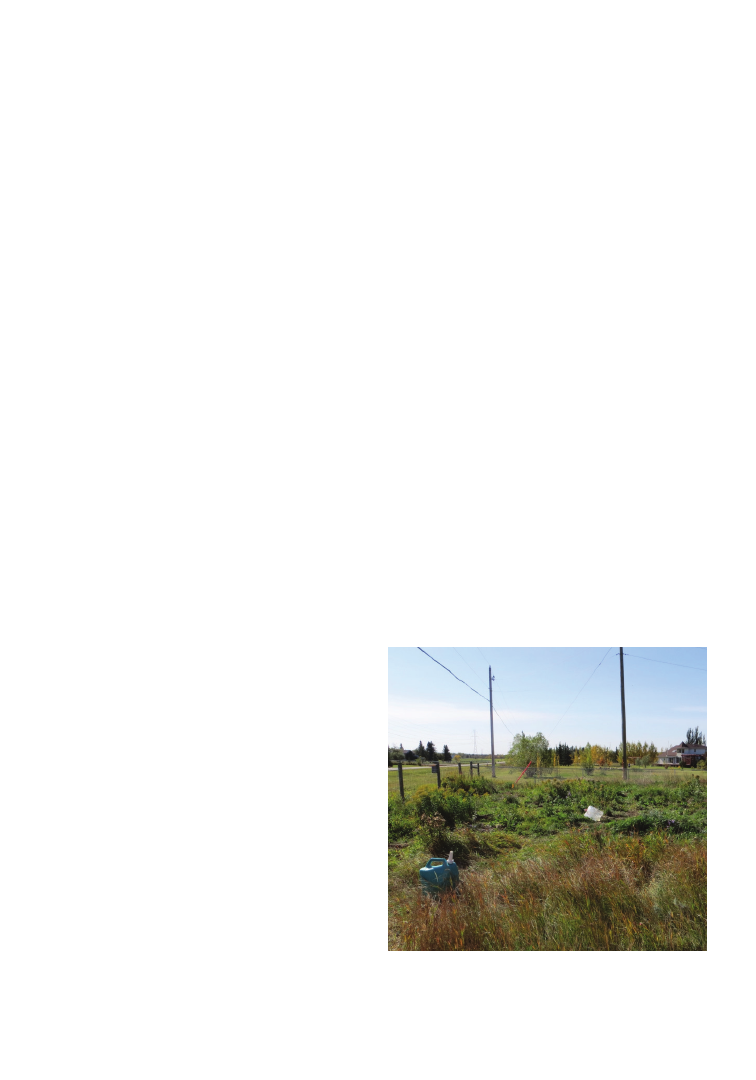
PSB 61 (4) 2015
Articles
142
ry in aspen woodland. Attempts at control of
brome colonies in the grassland have consist-
ed mostly of herbiciding with glyphosate. The
resulting patches of dead litter require repeat-
ed herbicide applications pending regenera-
tion with natives from surrounding grassland
or with transplants. Over the last half-dozen
years meadow foxtail (Alopecurus pratensis)
has become well established, likely getting its
start in the wet bottomlands of the Gwynne
Outlet and spreading up into the grasslands.
We are cutting and herbiciding it.
A heavily disturbed area near the gate where
rocks excavated from nearby fields were
dumped and then removed has been the focus
of volunteer efforts for the last few years. The
soil here is now so disturbed that we essential-
ly have a “garden,” with a seemingly inexhaust-
ible seed bank supply of annual and perennial
weeds such as stinkweed (Thlaspi arvense),
hemp-nettle (Galeopsis tetrahit), Canada this-
tle (Cirsium arvense), and sow-thistle (Son-
chus arvensis), along with smooth brome. We
have transplanted here seedlings and plugs
grown by volunteers from seed collected on
site or from the general area. The transplants
resemble those of the intact prairie communi-
ty neither in composition nor form. We grow
species that germinate easily and are robust in
habit, with the objective of creating as much
native ground cover as quickly as we can:
three-flowered avens, Richardson’s alumroot,
slender blue beardtongue, asters and golden-
rods, and various grasses. Natural succession
would eventually take care of the annuals, and
indeed patches of the perennial colonizer Soli-
dago canadensis complex are extensive, but we
assume that thistle and brome would persist
indefinitely among the natives if we did not re-
move them. We have not planted plains rough
fescue, despite the dominance of this grass in
mature prairies as its seedlings are unthrifty
and uncompetitive in early successional situ-
ations. Moreover, our Nisku populations have
not flowered significantly in four years, and
other sources of seed are few and far between
(Figure 4).
We are concerned that a number of native spe-
cies appear to have disappeared over the years,
usually those that were present originally in
small numbers. Examples include leathery
grape fern (Botrychium multifidum), Hooker’s
oatgrass (Avenula hookeri), long-leaved bluets
(Houstonia longifolia), and Drummond’s this-
tle (Cirsium drummondii). All of our grassland
species are wide-ranging in North America,
so their loss is only of local significance. Of
perhaps even greater concern is our suspicion
that numbers of commoner species are declin-
ing, which raises the question of whether this
is due to natural attrition, or our amateurish
and inconsistent management activities!
Our plans are to pay more attention to grass-
land health in the coming years, and to develop
a more scientific basis for assessing changes in
plant diversity. (A single-year inventory is not
sufficient. This year we had no appreciable rain
until late July, and several species did not flower
or flowered only in small numbers as a result.)
Figure 4. View of the disturbed rockpile area
near the gate, currently being transplanted with
native plugs. (Photo credit: Trudy Haracsi)
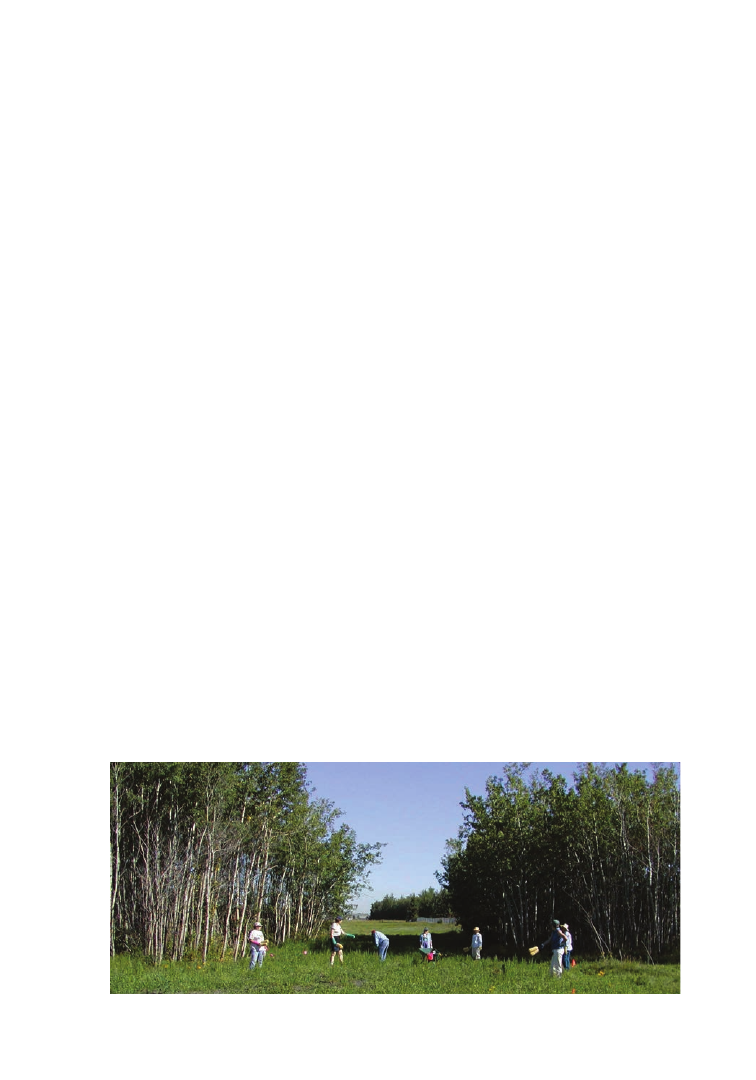
PSB 61 (4) 2015
Articles
143
Conservation of Grasslands
In many ways, the challenges of managing Ni-
sku Prairie are typical of those of small nat-
ural areas on publicly owned, provincial, or
municipal land. While the government can
prevail upon private industry to restore dis-
turbances caused by pipelines and other in-
dustrial activities, public money is not avail-
able for natural remnants whose purpose is
conservation or nature-oriented recreation.
The priority of urban municipalities is the
maintenance of parks and urban forests; for
rural ones it is agriculture and rural subdivi-
sions. Consequently, much of the stewardship
work falls on volunteers, who have their own
limitations: lack of equipment, appropriate
contacts and networks, expertise, time, and
availability. A somewhat brighter conserva-
tion and management picture is that of the
newly thriving land trusts, although even they
depend to a considerable extent upon volun-
teers for management (Figure 5).
The connectivity of small remnants to larger
natural landscapes is now recognized as of su-
preme importance for the long-term viability
of vegetation communities. Geographically,
Nisku Prairie is “connected” to the Gwynne
Outlet, which extends south into a deeper
valley supporting natural grassland commu-
nities. However, most of the acreage owners
have extended their properties, often used for
grazing horses, right down to the Channel
edge, severing an ecological connection. We
must likely accept that Nisku Prairie can make
no significant long-term contribution to the
conservation of grasslands in the aspen park-
land zone or in Alberta as a whole. Perhaps its
most important role then is anthropocentric
rather than ecocentric: to serve as a “living
museum” for public education and apprecia-
tion and for scientific study and experiment,
likely involving students from our various
post-secondary institutions. The continued
engagement of volunteers, especially younger
ones, is also vital, and we should be making
greater efforts at outreach.
Older people with farming backgrounds have
nostalgic ties to iconic species such as prai-
rie crocus, associations that can only lessen
in predominantly urban-raised populations.
Our stewardship goal should be to maintain
the health of the Nisku Prairie ecosystem for
as long as possible so that succeeding genera-
tions can appreciate our ancestral landscapes.
Such appreciation is basic to fostering attitu-
dinal changes that could mean that conserva-
tion of both small and large landscapes will
eventually be given the focus and the funding
it deserves.
Figure 5. Volunteers “wicking” smooth brome and reed canarygrass with glypho-
sate in a disturbed area. (Photographer unknown.)
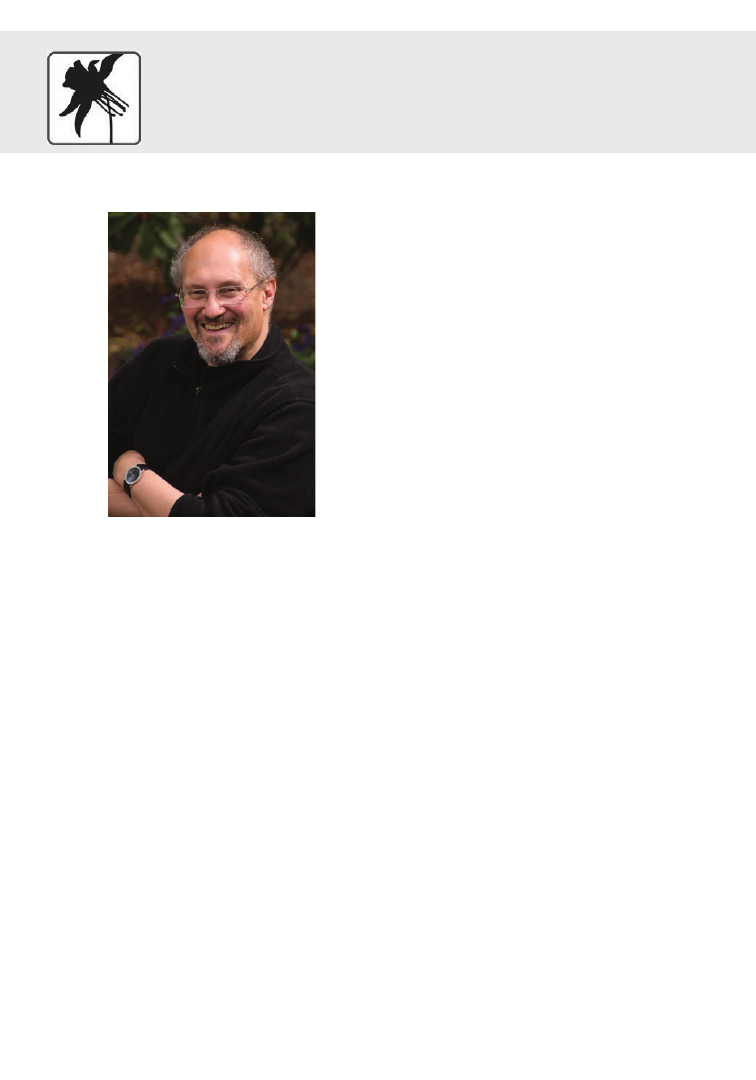
144
Announcements
Fred Sack (1947-2015)
Long-time BSA member Fred D. Sack died
on June 30, 2015, after a brief illness. He had
served as a Professor in the Department of
Botany at the University of British Columbia
from 2006 to his retirement in 2014 and as
Head of the department from 2006 to 2011.
Fred was born on May 22, 1947 in New York
City, the only child of Irving and Matilda Sack.
He graduated from Stuyvesant High School in
1964 and Antioch University in 1969, with a
degree in Sociology. While working in New
York City and living in Brooklyn, Fred en-
countered the Brooklyn Botanic Garden and
developed an interest in plants that eventually
led him to Cornell University for graduate school.
Fred received his Ph.D. from Cornell in 1982
for his research on stomatal development and
ultrastructure in the moss Funaria hygromet-
rica. A portion of Fred’s thesis appeared in the
American Journal of Botany in 1983, the first
of numerous AJB papers over his career. Af-
ter two years as a postdoctoral researcher at
In Memoriam
the Boyce Thompson Institute, Fred was hired
as an Assistant Professor in the Department
of Botany at The Ohio State University in
1984. He progressed through the ranks, and
remained there for 22 years. Fred’s research
interests in plants were broad and diverse and
included developmental anatomy, cell biology,
structure-function relationships, molecular
genetics, the cytoskeleton, and gravitational biology.
Fred’s interests in gravitational and space biol-
ogy led to extensive involvement with NASA
advisory boards, grants panels, and working
groups. He served on the National Acade-
my of Sciences Committee on Space Biology
and Medicine, the Space Studies Board, and
the National Research Council. From 1991
to 1993, Fred served on the Board of Direc-
tors of the American Society for Gravitational
and Space Biology; in 2004, he was awarded
the NASA Public Service Medal, and in 2005
he was appointed a Fellow of the American
Academy for the Advancement of Science.
Fred served as an Associate Editor for the AJB
from 2005 to 2013.
Over the course of his scholarly career, Fred
published over 110 papers and supervised
scores of graduate students and postdocs. He
was known for his enthusiasm, incisive think-
ing, quick wit, and collegial nature. Fred is
survived by his wife, Dian Clare, her three
sons and four grandchildren, and his twelve
cousins. In memory of Fred’s love of gardens
and his scientific interests, the Fred Sack Me-
morial Fund at the University of British Co-
lumbia will support the creation of a moss gar-
den around the Biological Sciences Building.
- Judy Jernstedt, University of California, Davis
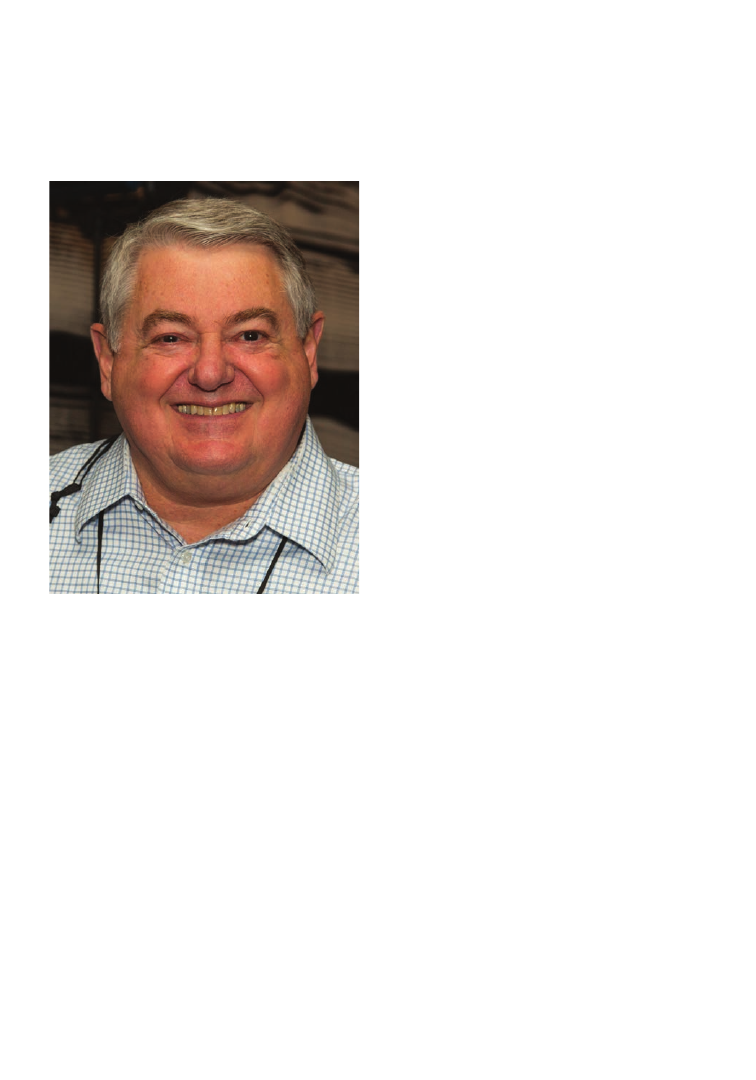
PSB 61 (4) 2015
145
Personalia
Dr. Edward L. Schneider
Named President and
Executive Director of
The Botanical Research
Institute of Texas
The Board of Directors of the Botanical Re-
search Institute of Texas (BRIT®) is delighted
to announce that Edward L. Schneider, Ph.D.,
has been named President and Executive
Director, effective December 15, 2015. Dr.
Schneider brings more than 30 years of bo-
tanical executive administrative experience to
BRIT and will lead the organization into the
next phase of its mission of conservation and
education.
“On behalf of the Board of Directors of BRIT,
I am excited to welcome Ed Schneider as the
new Executive Director,” said Board Chair-
man, Harry Bartel. “Dr. Schneider’s leadership
and fundraising skills are perfect for building
upon BRIT’s mission-based research and edu-
cation programs and extending the Institute’s
capabilities into each.”
BRIT’s search for a new executive director
began in June 2014 after long-time director
Dr. S. H. Sohmer announced his retirement.
The selection was made after an exhaustive
national search and selection process.
Louisiana State University
Names Its Herbarium for
Shirley C. Tucker
Boyd Professor Emerita Dr. Shirley C. Tucker
has given $2 million to the LSU Herbarium
and plant systematics program in the College
of Science Department of Biological Scienc-
es. Her gift, supplemented with an addition-
al $960,000 from the Louisiana Board of Re-
gents, creates a $2.96 million endowment to
support the Dr. Shirley C. Tucker Chair in
Plant Systematics, supports four superior
graduate student scholarships, and provides
endowed support for the LSU Herbarium.
In recognition of her distinguished career and
contributions to plant sciences at LSU and
beyond, the LSU Herbarium was named the
Shirley C. Tucker Herbarium during a ribbon
cutting ceremony held on October 15, 2015.
The ceremony was followed by a symposium
featuring guest speakers Irwin M. Brodo,
emeritus scientist at the Canadian Museum
of Nature in Ottawa and principle author of
Lichens of North America, and Chelsea D.
Specht, associate professor and curator of
Announcements
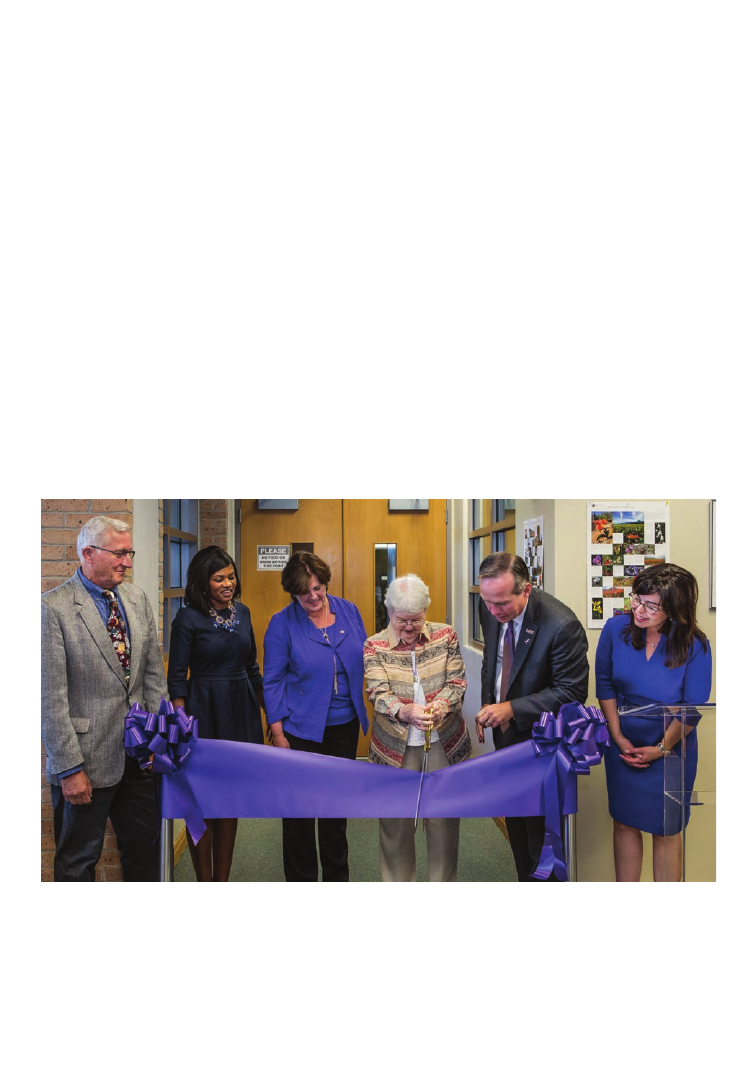
PSB 61 (4) 2015
146
herbarium lichen collection, which contains
44,000 specimens, one of the largest such col-
lections in the Southeast.
The Shirley C. Tucker Chair in Plant Systemat-
ics will provide perpetual support for an out-
standing faculty member in plant systematics
in the Biological Sciences Department and
additional funding for superior graduate stu-
dent scholarships to recruit top-performing
graduate students in plant systematics to LSU.
Tucker’s gift will also provide continuous and
reliable support to maintain and grow LSU’s
Herbarium collections.
“Dr. Tucker is a trailblazer in her field and
role model for aspiring botanists and women
in science. We are very excited to be a part of
monocots at the University of California,
Berkeley.
“I am grateful for the many enjoyable years I
spent as a faculty member at LSU. It is a plea-
sure to be able to show my appreciation with
this gift and to support a strong program in
plant systematics at LSU that will continue for
years to come,” said Tucker.
A renowned lichenologist and leading au-
thority on floral development in legumes and
other groups of flowering plants, Tucker was
one of the first women to receive LSU’s high-
est faculty rank of Boyd Professor. She has
written more than 150 publications on floral
development, plant systematics and lichen
studies. She is also credited for building LSU’s
Ribbon-cutting ceremony to celebrate the naming of the Shirley C. Tucker Herbarium at LSU. (L
to R) Shirley C. Tucker Herbarium Director Lowell Urbatsch, Senior Development Director for
the College of Science Emi Gilbert, College of Science Dean Cynthia Peterson, LSU Boyd Professor
Emerita Shirley C. Tucker, LSU President F. King Alexander, and LSU Foundation Vice President
for Development Ann Marie Marmande. Photo by Jim Zietz, LSU Strategic Communication.
Announcements

PSB 61 (4) 2015
147
her legacy of achievement,” said Cynthia Pe-
terson, dean and Seola Arnaud and Richard
Vernon Edwards Jr. Professor. “Shirley Tucker
has maintained a decades-long commitment
to the LSU Herbarium and her gift will allow
us to sustain this important facility and attract
additional talented faculty and students to the
plant systematics program.”
The LSU Herbarium is a testament to the geo-
graphical breadth and taxonomic depth of
Tucker’s lichen studies. Her interest in lichens
began in the 1950s as a student in the Bota-
ny Department at the University of Minneso-
ta. She began focusing on lichens in the Gulf
Coast region circa 1970 after reviewing LSU’s
historic Louisiana lichen collections of A.B.
Langlois from the late 1800s. Her research
collections also include vascular plants, bryo-
phytes, algae and fungi.
“Shirley C. Tucker’s generous, substantial do-
nation of funds for supporting the plant sys-
tematics program and the herbarium at Lou-
isiana State University is gratifying beyond
words. Since day one of my arrival at LSU in
1975, Shirley has been a resourceful, helpful
and personable colleague for me, for graduate
students, and for many scientists worldwide.
Knowing that all of her fine attributes will
be embodied forever in this fine gift will be a
source of inspiration for all of those who will
benefit from her generosity,” said Lowell Ur-
batsch, director and curator, Shirley C. Tucker
Herbarium.
Tucker retired from LSU in 1995 and con-
tinues a very active research program at the
University of California, Santa Barbara, the
Santa Barbara Botanic Garden and the Lou-
isiana State University Herbarium. In 2006,
she was inducted into the LSU College of Sci-
ence Hall of Distinction. She has also held a
number of prestigious leadership positions in-
cluding president of the American Society of
Plant Taxonomists and the Botanical Society
of America.
60 years ago:
“The Weed Society of America was founded at Fargo, North Dakota, in December 1954. All per-
sons who join this society during 1955 will be listed as charter members. Annual dues are $6.00; this
includes a subscription to the journal Weeds.” PSB 1(4): 3
Egbert H. Walker of the Smithsonian Institution reports on his experience as the Botanical Society
of America’s delegate to the 1951 meeting of the Botanical Society of Japan: “The outstanding im-
pression gained from the contacts at this convention is that the Japanese botanists are eager for closer
contacts and exchange with American botanists. The language barriers and the traditions of Japan,
and likewise of America, are obstacles that can be and are being slowly dissolved. I trust that my ap-
pointment as delegate from the Botanical Society of America and the Pacific Science Board has helped
accelerate a greater accord between the botanists of these two countries.” PSB 1(4) 4-5.
50 years ago:
C. A. Arnold reports on the death of Rudolf Florin (1894-1965): “The death of Professor Rudolf
Florin, Swedish paleobotanist, has terminated one of the most remarkable and productive botanical
research careers of modern times.” PSB 11(3): 11.
From the
PSB
Archives
Announcements

148
SCIENCE EDUCATION
By Catrina Adams,
Education Director
BSA Science Education News and Notes is a
quarterly update about the BSA’s education
efforts and the broader education scene. We
invite you to submit news items or ideas for
future features. Contact Catrina Adams, Ed-
ucation Director, at cadams@botany.org.
PlantingScience Awarded $2.9M
National Science Foundation Grant
We are extremely excited to announce that
BSA was awarded a $2.9 million NSF grant to
develop and study a new model of profession-
al development for teachers and early career
scientists. The grant funding will go toward
developing a sequence of in-person work-
shops and online learning platforms targeted
toward high school teachers new to Planting-
Science and their students, as well as graduate
students and postdocs. High school biology
teachers and early career scientists will work
collaboratively and learn from each other
while they co-mentor students on student-led
plant science projects through the Planting-
Science online mentoring platform. Our co-
PIs at the Biological Sciences Curriculum
Study (BSCS) will be conducting a rigorous
cohort-comparison study to measure impacts
of the new model on the students, teachers,
and scientist participants.
This is fantastic news for the program, since it
will allow us to move to a new platform where
we can support a larger number of student
teams, and it will help us to evaluate, improve,
publicize, and grow this powerful program.
We’ll make use of our 10-year history and the
strong existing PlantingScience community
as we create new online training and profes-
sional development resources. Many of these
resources will be available to the entire Plant-
ingScience community and will help improve
the quality of projects overall and give #page
ed guidance to students, mentors, and teach-
ers as they need it.
The grant will help us to provide leadership
opportunities for existing PlantingScience
scientist mentors, Master Plant Science Team
members, and teachers to focus their acquired
expertise towards training future program
participants. We will be in touch by e-mail as
opportunities arise.
This new professional development grant
means we will soon be expanding our reach,
but other factors are involved with this
growth. Our expansion in Canada, thanks
to increased partnership with the Canadian
Botanical Association, and development of a
new agriculture module in partnership with-
the American Society of Agronomy will be
very important in moving forward. In order
to handle the larger number of student teams
we’re anticipating, we’ll need more scientist
mentors willing to volunteer their time and
share their passion for plants and science.
Please consider joining us next fall!
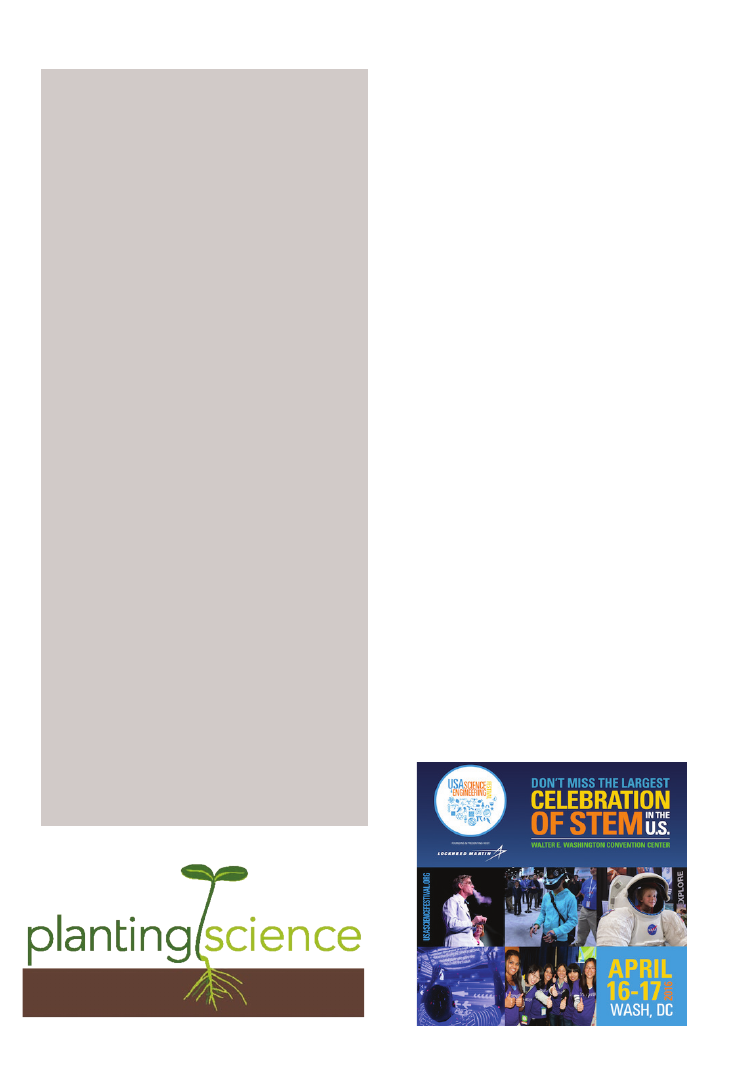
PSB 61 (4) 2015
149
Seeking new PlantingScience
mentors and middle and high
school teachers for Fall 2016.
PlantingScience is growing,
and we need your help!
If you have not yet mentored with
the program, please consider join-
ing us next fall. If you are a current
mentor, please consider recruiting
your colleagues to give mentoring
a try next year.
If you have or know a student in grades
6-12, please consider sending their bi-
ology teacher an invitation to check
out our website PlantingScience.org
and what we offer (free of charge)
to teachers. PlantingScience is a great
way for middle and high school stu-
dents and their teachers to learn more
about what plant science is like and to
meet and interact with scientists from
around the world.
Learn more at:
www.plantingscience.org
USA Science & Engineering
Festival, BSA Seeking Local
D.C. Area Booth Volunteers
This April the BSA will be participating in the
USA Science and Engineering Festival held in
Washington D.C., sharing booth space with
partnering organizations as part of a joint
“Plant Presence.” By partnering, we are able to
make a bigger impact for plant science among
a sea of biomedical and engineering exhibits
at the Festival. Over 350,000 attendees are ex-
pected, and we expect that over 10,000 people
will visit our Plant Presence booth each day.
This is a great way to capture the public inter-
est in plants and to increase their appreciation
of how important plants are to our daily lives.
We are seeking local BSA members to help
us share simple booth activities with D.C.
area schoolchildren and families at this 3-day
event held April 15 -17 at the Walter E. Wash-
ington Convention Center.
If you are in the area and would like to
share your passion for plants with the pub-
lic, please consider volunteering for a shift
at the booth. Please contact Catrina Adams
(cadams@botany.org) if you are interested in
learning more about the opportunity.
Science Education

PSB 61 (4) 2015
150
What Is QUBES? And What
Can It Do for You?
A message from
Carrie Eaton and the
QUBES team
QUBES stands for Quantitative Undergradu-
ate Biology Education and Synthesis.
• If you are an educator in biology that is on the
lookout for ways to explain or incorporate
quantitative concepts into your classes – this
is for you.
• If you are an educator in statistics, mathemat-
ics, or computational science that wants more
relevant biology motivating examples or data
to incorporate into your classes – this is for
you.
• If you are an educator somewhere in the in-
terface of mathematics and biology – this is
for you.
What is QUBES?
• We are a leadership team working with a
large network of institutions and professional
societies in all areas related to resources for
professional development in teaching quan-
titative biology (broadly inclusive).
• Our Hub website (https://qubeshub.org/) is a
collaborative space for sharing teaching ideas.
• You may have already seen us advertise FMNs
(Faculty Mentoring Networks), which are
cohorts of educators with the same mission
and motivation. They work together to share
quantitative biology education ideas and cur-
riculum in the same course, like introductory
biology, the same tool, like NetLogo or any-
thing else that brings them together.
What else can QUBES do for you? Just let us
know! What can you do for QUBES? Join the
conversation! https://qubeshub.org/
Next-Generation Careers:
Innovations in Environmental
Biology Education
The BSA is one of six professional societies
participating in a newly awarded NSF RCN-
UBE incubator headed by the Ecological So-
ciety of America and the Society for Conser-
vation Biology. The incubator is based around
discovering skill sets necessary for career ad-
vancement in the evolving field of environ-
mental biology, and how faculty, instructors,
and professional societies can help prepare
students for next-generation careers by help-
ing to address these skills.
As part of this project, the BSA will be help-
ing to distribute faculty surveys and hosting
a small focus group as part of the BOTANY
2016 meeting. A report and publication on
the findings of the project is planned for Jan-
uary 2017.
Stay tuned! Many workshops and discussion
sessions regarding the topic of nontraditional
scientific careers are planned for our BOTA-
NY 2016 meeting in Savannah.
Science Education

151
STUDENT SECTION
Round-up of Opportunities
for Students
By Angela McDonnell and Becky
Povilus, BSA Student Representatives
With the year coming to a close, you may be
thinking about what you want to do in 2016—
so here are some ideas! Gathered here are up-
coming opportunities for you to enrich your
CV, studies, and research. We have four cate-
gories for easy browsing: Grants and Awards,
Broader Impacts, Short Courses & Workshop,
and Job Hunting.
Grants and Awards
Grants and awards can fund your research,
travel for training or field work, and even
stipend. Grant/award applications are also a
great opportunity to plan and articulate your
research. Besides this list, remember to check
if your department or university has grants
suitable for application.
BSA Graduate Student Research Awards
$500
Botanical Society of America
Research Funds
Support and promote graduate student research in the botanical sci-
ences. Includes the J.S. Karling Award.
Deadline: mid-March
More info: botany.org/Awards
BSA Undergraduate Student Research Awards
$200
Botanical Society of America
Research Funds
Support and promote undergraduate research in the botanical scienc-
es.
Deadline: mid-March
More info: botany.org/Awards

PSB 61 (4) 2015
Student Section
152
BSA Student Travel Awards
Variable, up to $500
Botanical Society of America
Travel (conference)
Several awards support student travel to the annual BOTANY confer-
ence:
- Cheadle Student Travel Awards
- Triarch “Botanical Images” Student Travel Award
- BSA Section awards
Deadline: early-April,
variable
More info: botany.org/Awards
Cross-Disciplinary Training Grant
up to $3,500
microMORPH
Travel (research)
Foster cross-disciplinary training and interaction by allowing graduate
students to visit labs/gardens with the intent to enrich their research on
plant evo-devo, as related to questions or processes of microevolution.
Deadline: Spring and
Fall
More info: projects.iq.harvard.edu/micromorph
EDEN Research Exchange
up to $3,000
EDEN: Eco-Devo-Evo Network
Travel (research)
Allow graduate students to develop and disseminate experimental
techniques, community resources, and novel collaborations involving
research on new and emerging model organisms.
Deadline: April 30
and October 31
More info: www.edenrcn.com
NSF Graduate Research Fellowship Program
$32k/yr + tuition aid
National Science Foundation
Stipend & Tuition
Support outstanding graduate students in NSF-supported disciplines
who are pursuing research-based Master’s and doctoral degrees at
accredited U.S. institutions.
Deadline: October
More info: www.nsfgrfp.org
NSF Doctorial Dissertation Improvement Grant
up to $13,000
National Science Foundation
Research Funds
Provide partial support of doctoral dissertation research for improve-
ment beyond the already existing project (check that your project falls
within the scope of associated Divisions).
Deadline: October
More info: Click the “Funding” tab at http://www.nsf.gov
Torrey Botanical Society Fellowships and Awards
up to $2,500
Torrey Botanical Society
Research Funds &
Travel
Support research/education of graduate student society members
(fund field work, recognize research in conservation of local floral/eco-
systems, fund course attendance at a biological field station).
Deadline: mid-Jan-
uary
More info: http://www.torreybotanical.org
Prairie Biotic Research Small Grants
up to $1,000
Prairie Biotic Research, Inc.
Research Funds
Support the study of any species in U.S. prairies and savannas.
Deadline: late-De-
cember
More info: http://www.prairiebioticresearch.org

PSB 61 (4) 2015
Student Section
153
Botany In Action Fellowship
$5,000
Phipps Conservatory and Botanical Gardens
Research Funds
Develop new, science-based plant knowledge and chronicle tradition-
al knowledge of plants. BIA promotes interactive scientific education
about the importance of plants, biodiversity, and sustainable land-
scapes.
Deadline: mid-Jan-
uary
More info: www.phippsbotanyinaction.org
The Lewis and Clark Fund for Field Research
up to $5,000
American Philosophical Society
Research Funds
Encourage exploratory field studies for the collection of specimens and
data and to provide the imaginative stimulus that accompanies direct
observation.
Deadline: early
February
More info: www.amphilsoc.org/grants/lewisandclark
ASPT Graduate Student Research Grants
up to $1,000
American Society of Plant Taxonomists
Research Funds
Support students (both Master’s and doctoral levels) conducting field
work, herbarium travel, and/or laboratory research in any area of plant
systematics.
Deadline: early
March
More info: www.aspt.net/award
Richard Evans Schultes Research Award
up to $2,500
The Society for Economic Botany
Research Funds
Help defray the costs of field work on a topic related to economic botany,
for students who are members of the Society for Economic Botany.
More info: www.econbot.org
Sigma Xi Grants-in-Aid of Research
up to $1,000
Sigma Xi
Research Funds
By encouraging close working relationships between students and
mentors, this program promotes scientific excellence and achievement
through hands-on learning.
Deadline: mid-March
and October
More info: www.sigmaxi.org/programs/grants-in-aid
Young Explorers Grant
up to $5,000
National Geographic Foundation
Research Funds
Support research, conservation, and exploration-related projects con-
sistent with National Geographic’s existing grant programs. In addition,
this program provides increased funding opportunities for fieldwork in
18 Northeast and Southeast Asian countries.
Deadline: mid-March
and October
More info: www.nationalgeographic.com/explorers/grants-programs/young-ex-
plorers
Systematics Research Fund
up to $5,000
The Systematics Association & The Linnean Society
Research Funds
Besides research focused on systematics, projects of a more gener-
al or educational nature will also be considered, provided that they
include a strong systematics component.
More info: www.systass.org/awards

PSB 61 (4) 2015
Student Section
154
The Exploration Fund Grant
up to $5,000
The Exploration Fund Grant
Research Funds
Provides grants in support of exploration and field research for those
who are just beginning their research careers.
Deadline: late Oc-
tober
More info: www.explorers.org/expeditions/funding/expedition_grants
CIC Smithsonian Institution Fellowship
$32,700 for one year
CIC & the Smithsonian Institution
Stipend
One-year fellowships to support research in residence at Smithsonian
Institution facilities. All fields of study that are actively pursued by the
museums and research organizations of the Smithsonian Institution
are eligible.
Deadline: early-De-
cember
More info: www.cic.net/students/smithsonian-fellowship
Ford Foundation Fellowship Programs
$24k-45k, for 1-3 yrs
Ford Foundation
Stipend
Three fellowship types are offered: Predoctoral, Dissertation, and
Postdoctoral. The Ford Foundation seeks to increase the diversity of
the nation’s college and university faculties.
Deadline: late-No-
vember
More info: http://sites.nationalacademies.org/pga/fordfellowships/index.htm
The Arnold Arboretum Awards for Student Research
$2,000-10,000
The Arnold Arboretum
Research Funds
Four awards are offered for graduate students, with topics that focus
on Asian tropical forest biology and comparative biology of woody
plants (including Chinese-American exchanges). Check website for full
information on each award.
Deadline: late-No-
vember
More info: http://www.arboretum.harvard.edu/research/fellowships/
Garden Club of America Scholarships
$2,500-8,000
Garden Club of America
Research or Training
Funds
Many awards are offered to support botanical research, with foci rang-
ing from public garden history/use, field botany, medicinal botany, and
horticulture. Check website for full information on each award.
Deadline: January-
February
More info: http://www.gcamerica.org/scholarships
Broader Impact Opportunities
It’s not just for NSF grants! Sharing your passion for plants and science with a wide range of
audiences will develop speaking skills and can help you re-connect with the reason you decided
to go to grad school after all.
PlantingScience
What it is: A learning community where scientists provide online mentorship to stu-
dent teams as they design and think through their own inquiry projects.
What you can do: Interact with grade school-to-college students online, as they work on
plant-focused learning modules in the classroom.
More info: http://www.plantingscience.org/

PSB 61 (4) 2015
Student Section
155
Science Olympiad
What it is:
Competitions are like academic track meets, consisting of a series of 23
team events in each division (middle school or high school). Each year,
a portion of the events are rotated to reflect the ever-changing nature of
genetics, earth science, chemistry, anatomy, physics, geology, mechan-
ical engineering, and technology.
What you can do: Mentor local students in person on a variety of science and engineering
oriented topics and skills, help organize and run competitions
More info: http://www.soinc.org/
Local Arboretums, Parks, and Museums
What it is:
These institutions often depend on volunteers to donate their time and
expertise to help people of all ages enjoy their collections and grounds.
They may already have programs in place that allow you to lead tours
or interact with visitors at special events, so that you can share your
interests and passion.
What you can do: Lead tours; help organize and run events
More info: Look up local parks/arboretums/museums online, or inquire at visitors’
centers.
Short Courses and Workshops
These are a great way to learn new skills to add to your research. Here are a few of many op-
tions available to grad students for part of a semester or summer.
University of Idaho This two-week course is open to upper division undergraduates and
early career graduate students. In the course, you’ll gain valuable
experience and botanical knowledge in the field. You’ll also get
acquainted with the flora of Idaho in the Inland Northwest. Interested
students should look for an announcement in the spring.
June or July
More info: http://www.webpages.uidaho.edu/dtank/AFB/Advanced_Field_Bota-
ny.html
University of
Florida
This course highlights the biology and systematics of tropical plants,
specifically the extensive holdings of tropical vascular plants at
Fairchild Tropical Garden, The Kampong of the National Tropical
Botanical Garden, and the Montgomery Botanical Center. Field trips
will also be offered to the Everglades, the Florida Keys, and other ad-
jacent natural areas. Be on the lookout for an announcement during
the winter months.
June 26 - July 21
More info: http://www.flmnh.ufl.edu/herbarium/news/tropicalbotany.htm
Organization for
Tropical Studies
Courses through the Organization for Tropical Studies (OTS) are
a well-renowned way to spend a summer or semester in the field,
learning about the biology of tropical ecosystems in Costa Rica and
South Africa. Course offerings include Tropical Plant Systematics,
but check their website for the full list of offerings.
Variable dates
More info: www.ots.ac.cr
Advanced Field Botany
Tropical Botany Summer Course
OTS Courses in Tropical Field Biology

PSB 61 (4) 2015
Student Section
156
Arnold Arboretum
of Harvard Univer-
sity
microMORPH summer short-courses give students a 2-week immer-
sive learning experience amid the expansive living collections and
the state-of-the-art microscopy facilities of the Arnold Arboretum.
Topics in past years have included plant anatomy (with a focus on
wood anatomy), and plant morphology; the topic for 2016 has not yet
been decided. Applications will be solicited in the spring.
late June - early
July
More info: http://projects.iq.harvard.edu/micromorph/courses-0
Marine Biological
Library at Wood’s
Hole
This 10-day course features a series of lectures, discussions, and
bioinformatics exercises. Included are sessions on phylogenetic
analyses, population genetics analyses, databases and sequence
matching, molecular evolution, and comparative genomics. Applica-
tions for participation are due on April 4, 2016.
July 17 - July 27
More info: molevol.mbl.edu/index.php/Main_Page
UC Davis and the
Bodega Marine
Laboratory
This week-long course for will cover topics in statistical phylogenetics
and gives students the opportunity to complete a project during the
course. The schedule will likely include sessions on Bayesian inter-
ference, divergence-time estimation, MCMC diagnosis and model
selection, biogeography, continuous and discrete trait evolution,
species tree inference, and rates of lineage diversification.
March 5
-12
More info: www.treethinkers.org
Missouri Botanical
Garden
This workshop is one way to get exposure and experience working
with R: a powerful statistical software package. No dates are current-
ly set for the next three-day crash course, but it is likely that it will be
taught again next May in St. Louis by scientists from the Center for
Conservation and Sustainable Development. Look out for a formal
announcement in December or January and watch their website.
May
More info: www.rbasicsworkshop.weebly.com
online
edX, a free online course provider, offers a seven-part course on
data analysis for the life sciences (PH525.1-7). These courses are
a self-paced way to learn the using R for statistical analysis, starting
with basic R use to dealing with genomic datasets. These courses
combine video lectures, practical exercises, and a discussion board
monitored by course developers.
Variable times
More info: search “PH525” on www.edx.org
microMORPH Short-Course in Organismic Plant Biology
Molecular Evolution Workshop
Bodega Bay Applied Phylogenetics Workshop
The R Basics Workshop
edX: Data Analysis for the Life Sciences

PSB 61 (4) 2015
Student Section
157
Masters/PhD/Post-Doctoral Opportunities
These types of jobs are easily searchable on the “EvolDir” website under “PostDocs” and
“GradStudentPositions.” Click the icon, and listings will pop up in a list from the newest to
the oldest. This site shows positions from across the biological sciences but is a great option
for plant evolutionary biologists.
EvolDir
http://www.evol.mcmaster.ca/brian/evoldir.html
Academic Teaching Positions
Check the BSA website; click on the “Careers/Jobs” tab, and you can select “Post-doctoral,
Fellowship, and Career Opportunities” link to see a current list of a variety of job postings.
The BSA website is a great resource for one-stop-shopping for careers and other opportu-
nities in a variety of botanical sciences. Another good resource for finding jobs (including
postdoctoral opportunities) can be found through AAAS, at the Science Careers site.
Botanical Society of America jobs.botany.org
AAAS Science Careers jobs.sciencecareers.org/jobs/botany-plant-science
Government Positions and Non-Academic Jobs
Searches for government jobs can begin atusajobs.gov and americajobs.com. A good re-
source for non-academic jobs is the Conservation Job Board; this site allows you to search
within various fields by state and is updated regularly. Networking sites like LinkedIn and
ResearchGate will help you connect with and organize your professional contacts---be sure
to keep your profile pages updated and polished!
Government Positions
www.usajobs.gov
www.americajobs.com
Conservation Job Board www.conservationjobboard.com/category/botany-jobs
Use your University!
Many academic institutions have offices that focus on helping alumni succeed after grad-
uation. Check with your department or institution for resources on job announcements, work-
shops focused on personal development (such as CV/resume writing or getting a teaching
certificate), and networking opportunities.
What’s Next: Looking for a Job in Botany
Before you have your degree, or if you are looking to switch jobs, it is important to consider
your next step, whether it be finding a PI and lab to work in for continuing your education,
finding a post-doctoral research opportunity, or finding a job that suits your goals and skills.
Finding out about jobs often happens through personal contacts, but there are great online
resources as well.

158
BOOK REVIEWS
Ecological
Ecological Statistics: Contemporary Theory and Application .......................................... 158
Systematics
Flora of North America, Vol 9 .............................................................................................................. 160
Flora of Oregon, Vol 1.............................................................................................................................. 161
Ecological
Ecological Statistics:
Contemporary Theory and
Application
Gordon A. Fox, Simoneta Ne-
grete-Yankelevich, and Vinicio J.
Sosa, editors
2015. ISBN-13: 978-0-19-967255-4
Paperback, £39.99. 416 pp.
Oxford University Press, Oxford, United Kingdom
Not so long ago, ecologists were free to frol-
ic in flowered meadows and poetically report
findings that “[could not] be merely acciden-
tal, because they so often tend in the same di-
rection” (Bumpus, 1899). And although some,
no doubt, yearn for a return to this descrip-
tive way of science, it seems undeniable at this
point that researchers entering or continuing
on in the field must become fluent in the lan-
guage of statistics. This task is especially dif-
ficult because our understanding of statistics
has changed dramatically in the past decade
and continues to change daily. Driven in part
by access to ever-improving computing pow-
er, many of the statistical techniques used in
contemporary work were little known a gen-
eration ago—if they existed at all. The ques-
tion then becomes: how do we best teach sta-
tistics to our students and ourselves?
Ecological Statistics: Contemporary Theory and
Application is one answer to this question—
and it’s a good one at that. Best suited as an
overview for graduate students or researchers
with standard mathematical backgrounds, the
text begins with basic probability, but quickly
turns to more specific relevant issues like the
effects of ecological data constraints on anal-
ysis. Ecological Statistics excels at building a
working conceptual understanding of statis-
tics rather than treating each topic piecemeal
as is common in other texts. The value of this
conceptual understanding is especially rele-
vant for those interested in working with the
complex, imperfect, and sometimes uncon-
ventional nature of biological data.
The topics covered are diverse, including gen-
eralized linear models, structural equation
modeling, and phylogenetic analysis. These
chapters vary widely in technicality, but all
employ straightforward writing and support-
ing illustrations. Chapters 1–3 are, most sim-
ply, a discussion of the concepts that follow in
the successive chapters. The authors provide
not only the basic tools you will use later in
the book, but also a map of where those tools
may come in handy. These tools include unbi-
ased data collection, sample statistics and con-
fidence intervals, likelihood, model selection,

PSB 61 (4) 2015
159
and non-parametric methods, among others.
The successive chapters use variations of these
basic tools with sample data to more fully
develop the ideas discussed. Chapter 4 talks
specifically about the ever-present and of-
ten-confounding conundrum of what to do
with missing data, while Chapter 5 talks more
generally about deftly handling censored or
truncated data. Chapter 6 is a particularly
well-written chapter by Yvonne M. Buckley
that discusses in depth the correct applica-
tion of the generalized linear model, as well
as many of the method’s common pitfalls and
complications. Chapter 8 discusses the process
of combining simple models into more com-
plex causal models, while Chapter 9 discusses
combining models from different studies into
informative and transparent meta-analyses.
The final four chapters cover the correlation
structure of data, with Chapter 10 focus-
ing on spatial variation and linear modeling
and Chapter 11 focusing on phylogenetically
correlated data. Chapter 13 discusses using
mixture models for overdispersed data, and
Chapter 13—another exceedingly well-writ-
ten section, this time by Benjamin M. Bolk-
er—examines linear and generalized linear
mixed models.
This broad treatment of the field has inevita-
bly left some relevant topics out in the cold—
notably, non-linear models, multivariate tech-
niques, and time series—but in general, the
book gives enough background to serve as
a springboard for the reader to delve deep-
er into topics they find particularly relevant.
Additionally, as a consequence of the text’s
conceptual nature, some readers may find
a more succinct resource to be helpful later
when they are looking to perform a certain
task. The authors and editors have dutiful-
ly placed example R code for most chapters;
however, these snippets are often isolated by
substantial blocks of crucial explanatory text
or supporting mathematical notation, making
quick reference challenging. It also seems that
further utility could be gained with addition-
al problem sets for students to work through
independently.
Despite these small gripes, Ecological Statis-
tics: Contemporary Theory and Application is
an amazing piece of work that deftly performs
the unenviable task of presenting the “need to
know” methods of a complex field. While the
first six chapters alone make this text a wor-
thy purchase, not every chapter may prove to
be adequate for every course. However, the
logical progression of the chapters may serve
well as a structure for instructors to build on.
This book would be a valuable addition to any
course asking students to expand their statis-
tical comfort zone, but also easily lends itself
to self-study for those wishing to join the con-
versation of ecological statistics.
–Chase L. Nuñez, University Program in Ecol-
ogy, Nicholas School of the Environment, Duke
University, Durham, North Carolina, USA
LITERATURE CITED
Bumpus, H. C. 1899. The elimination of the unfit as il-
lustrated by the introduced sparrow, Passer domesti-
cus. Biological Lectures, Woods Hole Marine Biological
Station 6: 209–226.
Book Reviews

PSB 61 (4) 2015
160
Flora of North America: North of
Mexico; Vol. 9: Magnoliophyta:
Picramniaceae to Rosaceae
Flora of North America Editorial
Committee
2015. ISBN-13: 978-0-19-534029-7
Hardcover, US$95.00. 752 pp.
Oxford University Press, New York, New York, USA
Volume 9 of the Flora of North America (FNA)
covers only four families, Picramniaceae,
Staphyleaceae, Crossosomataceae, and Rosa-
ceae. However, at over 700 pages, it is one of
the largest volumes published. Volume 9 is the
18th out of 30 to be published and represents
1.5% of the vascular families that will be cov-
ered. Treated within the volume are two spe-
cies each of Picramniaceae and Staphyleaceae,
seven of Crossosomataceae, and 680 of Rosa-
ceae. The FNA is designed for both the bot-
anist and nonbotanist and contains dichot-
omous keys for identifying North American
species and detailed treatments of taxa. The
Introduction, which is fairly verbatim among
volumes, has a very detailed explanation on
how to read and interpret the species’ treatments.
While the FNA, by design, covers North
America north of Mexico, the map of North
America on the inside front and back covers
depicts all of North America, Central Ameri-
ca, and much of the Caribbean. Of this addi-
tional land area, only Mexico is fully delineat-
ed and labeled. I suspect this was intended to
give reference to the area covered by the flora,
but I think this gives the map an incomplete
appearance. Likewise, the District of Colum-
bia is listed on the legend for this map, but it
is not labeled on the map itself. The smaller
occurrence maps for each species only include
the flora area. To be consistent within the vol-
ume, it might have been practical to drop the
extra land area. On the other hand, this map
design is entirely consistent with all previous-
ly published volumes of the FNA, with the ex-
ception of updates to Canadian territories.
Within the Basic Concepts section of the In-
troduction, it states that taxa treated in full
include native species, as well as waifs or cul-
tivated plants that are found frequently out-
side of cultivation. This is further elaborated
later in the Introduction where it states that at
least one specimen from each geographic unit
record should have been seen by the authors.
In practice, inclusion in this volume of the
Flora seems generous. Potentilla sterilis has
had its native status questioned and has one
historical documentation from 1928. No cur-
rent occurrences are known, and no voucher
was seen (p. 132). Likewise, Potentilla erecta
is questioned as being an extant naturalized
species and is no longer known where it is
historically reported (p. 136). Acaena pallida
is known only from a single collection from
California (p. 325). I think generous inclu-
sion for the Flora is justifiable. Introductions
of species will only continue so these species
may appear on the landscape in the future.
In some previous volumes (2–4, 22, 24–26),
the occurrence maps are range maps with
shaded regions where the species occur. How-
ever, Volume 9 and other recently published
volumes have a simplified dot occurrence
map. Even though ranges have become frag-
mented, I think the range maps are more in-
formative and better represent the species’
geographic ranges rather than using politi-
cal boundaries. For instance, one dot occur-
rence in Quebec could represent a geograph-
ic range larger than the combined region of
all New England states with dot occurrences.
This might suggest to the nonbotanist that a
species is only found in Quebec versus being
found all over New England. It is also difficult
to detect dots on small political divisions on
Book Reviews
Systematics

PSB 61 (4) 2015
161
the map, although this is not necessarily a
concern because occurrences are listed in the
species treatments as well.
The illustrations in the volume are very nice.
Twenty-eight percent of the species in the
volume are illustrated, including species in
each of the four families. Other published vol-
umes have illustrations that are easily sized
to one-half of a page, but in this volume they
are smaller, closer to one-third of a page. This
probably conserved space in this large vol-
ume, but there does not seem to be any loss
of detail. In fact, the Rosaceae illustrations are
quite detailed, enough so to highlight subtle
differences between similar species, such as
those within the genera Rosa or Potentilla, es-
pecially as there are scale bars for each species
within an illustration—helpful to nonbota-
nists who may not have an eye for the differ-
ence between 1 and 2 mm. Illustrated species
have a box code of “F” within their treatment,
but unfortunately within the treatment there
is no page number listed for the illustration.
One must either flip some pages to search for
it (e.g., Geum triflorum is treated on p. 62, but
the illustration is on p. 52 within the Rubus
treatments) or find the species in the index.
The italicized page numbers in the index spec-
ify the page of the illustration, but the font
used in the book does not allow italic num-
bers to be easily discerned.
The keys in this volume work well too. For the
Rosaceae, there is an 18-couplet key to sub-
families and tribes; the keys for Picramniace-
ae, Staphyleaceae, and Crossosomataceae are
simple and lead directly to genus or species.
I collected three specimens on the walk to
my office and had them keyed out and treat-
ments fully read in short work—as the process
is intended. It took nine couplets to arrive at
Chaenomeles speciosa, 11 for Duchesnea indi-
ca var. indica, and 15 for Rubus allegheniensis
(most likely a hybrid cultivar). The couplets
Flora of Oregon, Vol. 1: Pteri-
dophytes, Gymnosperms, and
Monocots
Steven C. Meyers, Thea Jaster, Katie
E. Mitchell, and Linda K. Hardison
(editors)
2015. ISBN-13: 978-1-889878-46-1
Cloth, US$90.00. xiv + 591 pp.
Botanical Research Institute of Texas, Fort Worth,
Texas, USA
My first thought on opening this book was,
“How do I preserve the beautiful dustcov-
er?” My second thought was, “There should
be some special recognition of Tanya Harvey,
for layout and design of this elegant volume.”
There is now a new standard of excellence for
a state flora.
Book Reviews
are easy to navigate and, in addition to vegeta-
tive information, contain details for flowering
and fruiting stages aimed at those frustrating
times when one or the other is unavailable.
There is no glossary of botanical terminolo-
gy, however, which may make it more difficult
for the nonbotanist. The Introduction refers
to the book Categorical Glossary for the Flo-
ra of North America Project and lists a website
for its online access. The link given no longer
appears to work, but I found the website by
searching online for the title.
This is a hefty book, so it’s no good as a field
guide. However, the FNA, including this vol-
ume, is also published online (www.fna.org).
This makes it a useful tool in the lab or class-
room, but the complete 30-volume set would
be a splendid addition to any botanist’s (or
anyone’s!) library.
– Adam Ramsey, Department of Biological Sci-
ences, University of Memphis, Memphis, Ten-
nessee, USA

PSB 61 (4) 2015
162
Cover 2 and its facing page are full-color il-
lustrations of the eleven Oregon ecoregions:
Cascades, Coast Range, Willamette Valley,
etc. Cover 3 is the family index, and its facing
page is an outline map of Oregon’s counties,
with the county seat of most counties indicat-
ed. The adopted family names mostly follow
Angiosperm Phylogeny III.
The actual keys begin on page 65. That is to
say, there are 64 pages of introduction, ex-
planation of keys, and page after delightful
page of Oregon’s pioneer and contemporary
botanists, including portraits and extensive
biographical details. These pages also include
extensive coverage of “Exploring Oregon’s
Botanical Diversity,” replete with color pho-
tographs—these are national parks, national
forest lands, etc. One of the sketches men-
tions Luina serpentina Cronquist, an Oregon
endemic. I had never heard of this plant, so
I turned to the index, to no avail. (Not sur-
prisingly, it turns out it’s in the Asteraceae, not
covered in this volume.) As I subsequently
discovered, nothing in these opening pages
is included in the index to this volume. Alas,
readers can only page through themselves, to
discover these riches. (Sketches of the lives of
the four editors are only included on the back
flap of the dustcover.)
The arrangement of the accepted taxa is alpha-
betical throughout, with the running heads
dictionary-like. This is yet another example
of how much thought went into the book’s
design. All species are mapped; the maps in-
clude dots for actual specimens, plus shading
to indicate their occurrence in Oregon’s elev-
en ecoregions; furthermore, the names of the
ecoregions (most abbreviated) are given at
the end of each description, followed by the
range outside of Oregon. A great many are
illustrated with line drawings, which are far
more useful than photographs. The descrip-
tions are very ample. The authors of accepted
taxa are given without abbreviation, although
the authors of synonyms are conventionally
abbreviated. None of the Latin is explained or
translated, and no references to type descrip-
tions are given. English names are given; I
forbear to call them common names, because
most of them appear to be mere translations
of the Latin. “Long-bearded mariposa-lily”
is scarcely plausible as a name that can come
trippingly on the tongue.
Just before the index, there are five appendi-
ces. One of the most interesting is the fifth
one, “Native taxa not collected in the past 50
years.” If I were an Oregonian, I would adopt
this list as an action plan for plant collecting.
Table 1 of Appendix 1 lists taxa excluded from
full treatment because they are known from
a single Oregon population, or because they
are mere waifs. Table 2 of Appendix 1 lists well
over 100 species that have been credited to Or-
egon, but which turn out to be unvouchered
(for the most part) or with misidentified
vouchers. I cannot recollect ever having seen
such lists in a flora before. Their inclusion
speaks to the care with which the editors and
taxon authors have approached their material.
The appendices include the entire flora, not
just the taxa treated in Volume 1. However,
only the scientific names relevant to Volume 1
that appear in Appendix 1 are included in the
index for Volume 1, but without reference to
their occurrence in Appendix 1 itself.
There are to be three volumes, comprising the
dicots. I learned by e-mail that the publishing
target dates for Volumes 2 and 3 are autumn
of 2017 and (late) 2019, respectively. The Ore-
gon Flora Project is off to a splendid start, and
I feel sure the next two volumes will be eagerly
awaited.
–Neil A. Harriman, Biology Department, Uni-
versity of Wisconsin–Oshkosh, Oshkosh, Wis-
consin, USA; harriman@uwosh.edu
Book Reviews
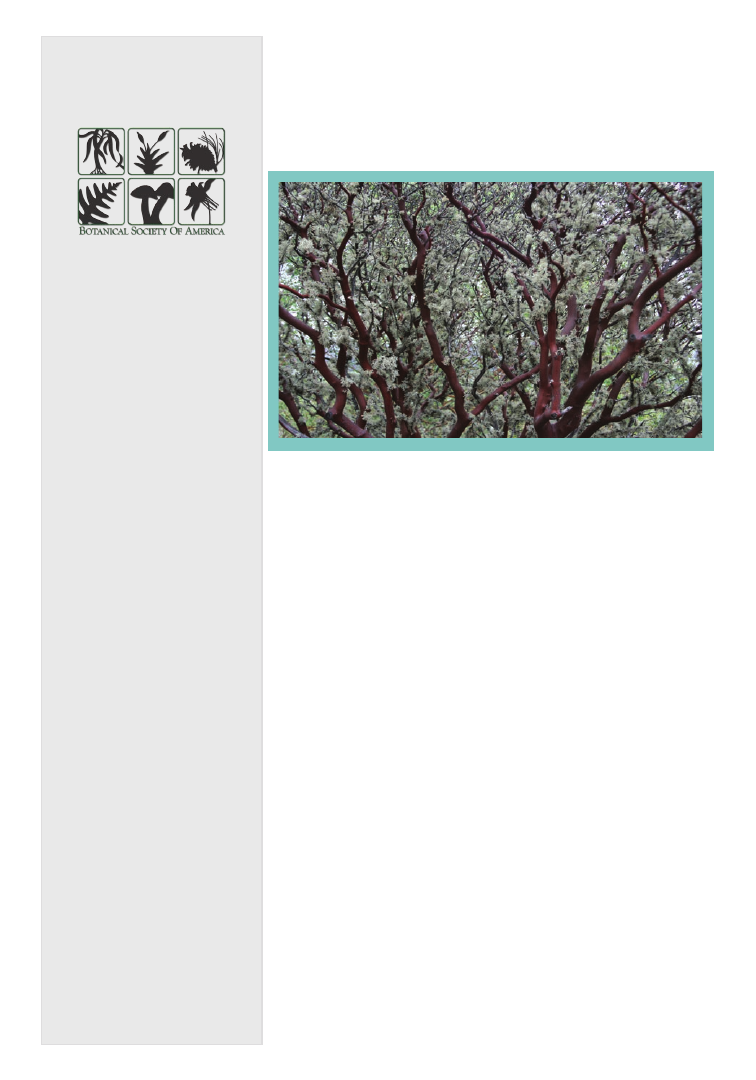
Plant Science Bulletin
Featured Image
The Botanical Society of
America is a membership soci-
ety whose mission is to: pro-
mote botany, the field of basic
science dealing with the study
& inquiry into the form, func-
tion, development, diversity,
reproduction, evolution, & uses
of plants & their interactions
within the biosphere.
ISSN 0032-0919
Published quarterly by
Botanical Society of America, Inc.
4475 Castleman Avenue
St. Louis, MO 63166-0299
Periodicals postage is paid at
St. Louis, MO & additional
mailing offices.
POSTMASTER:
Send address changes to:
Botanical Society of America
Business Office
P.O. Box 299
St. Louis, MO 63166-0299
bsa-manager@botany.org
The yearly subscription rate
of $15 is included
in the membership
Address Editorial Matters
(only) to:
Mackenzie Taylor, Editor
Department of Biology
Creighton University
2500 California Plaza
Omaha, NE 68178
Phone 402-280-2157
psb@botany.org
Plant Science Bulletin
Fall 2015 Volume 61 Number 4
Spring branches of Arctostaphylos viscida (whiteleaf man-
zanita) draped in lichen (possibly in the genus Evernia).
Smooth bark and a rich red to brown color are good indica-
tors that trees or shrubs seen while hiking in Oregon and Cal-
ifornia belong to the Arbutoideae subfamily of the blueberry
family, Ericaceae. The manzanitas, in the genus Arctostaph-
ylos, can form dense thickets as a dominant or co-dominant
member of chaparral plant communities. The manzanita seen
here, Arctostaphylos viscida, produces seeds that can remain
dormant in the soil for many years, until stimulated to ger-
minate by fire, allowing this shrub to establish quickly after
an area burns. The branches of this manzanita are draped in
lichen, a separate organism that does not harm the plant, but
does use the branches as habitat. While the productivity of a
community is often thought to be driven by the photosynthe-
sis performed by plants, cryptogams such as this lichen per-
form photosynthesis as well and may account for about %7 of
the net primary productivity worldwide. Bacteria within the
lichen can also obtain nitrogen from the air, processing it into
a form that can be used by plants and animals which are un-
able to secure this important resource from the atmosphere.
Photo by Kevin Weitemier, Botany & Plant Pathology De-
partment, Oregon State University.
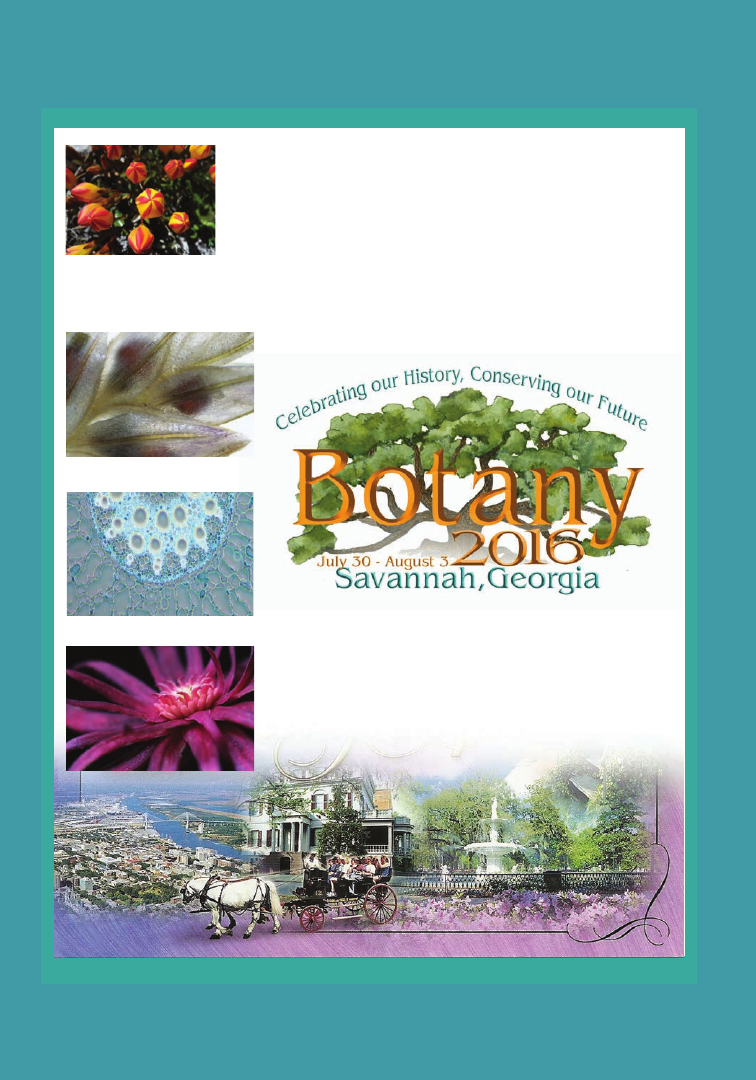
Be sure and view the video at:
botany.org
See You In Savannah !
Savannah International Trade and
Convention Center
www.botanyconference.org